|
Sauces & Condiments
 Sauces
and condiments for foods were almost a necessity prior to the marvelous food
preservation advances of the 20th century. The foods available during the 19th
century (and before) were often of dubious quality and taste - or at least
bland - necessitating the use
of a wide array of sauces to either enhance the flavor or cover up
off-flavors (Rinker 1968). Given this fact, sauces and condiment bottles are very
commonly associated with historic sites dating from the entire time span covered
by this website, i.e., 19th through mid-20th centuries. Probably the
most familiar example and one of the most commonly found "food" bottles
is the ubiquitous Lea & Perrins Worcestershire Sauce - a product that is still
quite popular now (and discussed
later). Sauces
and condiments for foods were almost a necessity prior to the marvelous food
preservation advances of the 20th century. The foods available during the 19th
century (and before) were often of dubious quality and taste - or at least
bland - necessitating the use
of a wide array of sauces to either enhance the flavor or cover up
off-flavors (Rinker 1968). Given this fact, sauces and condiment bottles are very
commonly associated with historic sites dating from the entire time span covered
by this website, i.e., 19th through mid-20th centuries. Probably the
most familiar example and one of the most commonly found "food" bottles
is the ubiquitous Lea & Perrins Worcestershire Sauce - a product that is still
quite popular now (and discussed
later).
Sauces and condiments are lumped together in this
section due to the similarity of the products, i.e., flavoring garnishments for foods. Sauces are usually considered condiments, though not all
condiments are sauces - if one defines sauce as being more liquid than not.
However, these two categories of bottles do have some functional differences from each
other as to the general shapes. Sauces (e.g., pepper
sauce, catsup/ketchup, club sauces) are most commonly bottles that are relatively tall
and narrow with narrow bores reflecting their more or less liquid and
"pour-able" nature. Condiments (e.g., mustard, horseradish) tend to be thicker,
less "pour-able" substances than sauces; an attribute that necessitated
bottles with wider bores to facilitate access to the product with a knife
or other implement.
Although not covered as a specific category, the bottle pictured to the
above left would be considered typical of the shape
of bottles used for sauce during the earliest part of the era covered by this
website (1800-1850). These somewhat uniquely shaped bottles were
probably manufactured by various processes - free-blown, dip molded, or two or
three-piece molded (like the
pictured example), would have pontil scarred or smooth bases (like this
example; click
sauce base to view an image of this bottles slightly pushed-up base), and date from the 1830s to 1870s
era. The pictured bottle was likely used for "oyster ketchup" as it
was excavated in
San Francisco, CA. from the location of an alleged bottle recycler in context with various other identifiable sauce
bottles including the embossed Shriver's Oyster Ketchup bottles (Baltimore, MD. -
mid 1850s to 1860s) which are virtually identical in shape and (sometimes)
color though embossed with the product name (Zumwalt 1980; Baltimore
Bottle Club 2002). However, bottles
of this general shape could - and probably were - used
for a variety of liquid substances (e.g., liquor, medicine) since during the first half of the 19th century
(and before) bottle stylistic variety
was limited and the same "type" bottle was often used for many
different products
(McKearin & Wilson 1978; Jones & Smith 1985; Hume 1991).
The sections addressed under this "Sauces & Condiments"
heading cover some of the more commonly encountered
types. The reader should be aware that there were likely thousands of
uniquely different sauce bottles made during the era covered by this website if one includes
the plethora of subtle variations on the major thematic styles
presented here.
|
Gothic or cathedral
styles
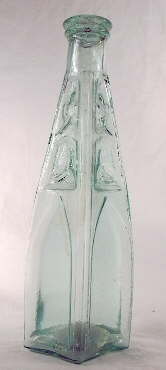 One
of the earliest of the distinct U. S. bottle styles strongly identified
with sauces were the gothic or "cathedral" styles. These designs (also see the gothic pickle
bottle section later on this page) originated during the mid-19th century
"Gothic Revival" period in American and Europe which also had its effects
on the architecture of the period (Deiss pers. comm. 2003). This style varies in specific design
but all share the distinction of having varying sized peaked "church window" like panels
on most or all of the sides. Gothic sauce bottles were made in both square
and hexagonal cross-section shapes and are often quite ornate in appearance - an
early and apparently successful attempt to use packaging to attract the
eye of potential purchasers by stylistically emulating the already popular Victorian gothic design
elements of the 19th century. These gothic style bottles do seem to
be distinctly American in origin and manufacture (McKearin & Wilson 1978).
Some less ornate designs
simply have the long lower body indented and peaked panels without the
upper smaller panels, or just one upper panel instead of two. These
would all be considered as gothic styles. One
of the earliest of the distinct U. S. bottle styles strongly identified
with sauces were the gothic or "cathedral" styles. These designs (also see the gothic pickle
bottle section later on this page) originated during the mid-19th century
"Gothic Revival" period in American and Europe which also had its effects
on the architecture of the period (Deiss pers. comm. 2003). This style varies in specific design
but all share the distinction of having varying sized peaked "church window" like panels
on most or all of the sides. Gothic sauce bottles were made in both square
and hexagonal cross-section shapes and are often quite ornate in appearance - an
early and apparently successful attempt to use packaging to attract the
eye of potential purchasers by stylistically emulating the already popular Victorian gothic design
elements of the 19th century. These gothic style bottles do seem to
be distinctly American in origin and manufacture (McKearin & Wilson 1978).
Some less ornate designs
simply have the long lower body indented and peaked panels without the
upper smaller panels, or just one upper panel instead of two. These
would all be considered as gothic styles.
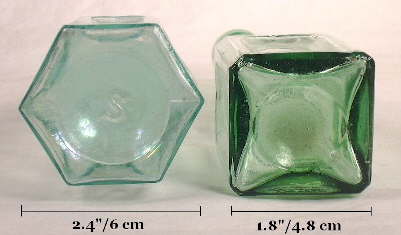 The example to the left is
typical of the style with three separate panels
on each side with the two upper panels having additional decorative
features inside the panel. Incidentally, glassmakers universally
called this style "gothic" as in "gothic pepper sauce"; the term
"cathedral" does not appear ever in glassmakers catalogs to this
authors knowledge
(Whitall Tatum & Co. 1880, 1902; Illinois Glass Co. 1903; Obear-Nester Co.
1922). The cathedral designation almost certainly modern collector jargon. The example to the left is
typical of the style with three separate panels
on each side with the two upper panels having additional decorative
features inside the panel. Incidentally, glassmakers universally
called this style "gothic" as in "gothic pepper sauce"; the term
"cathedral" does not appear ever in glassmakers catalogs to this
authors knowledge
(Whitall Tatum & Co. 1880, 1902; Illinois Glass Co. 1903; Obear-Nester Co.
1922). The cathedral designation almost certainly modern collector jargon.
Both the four (square) and six sided (hexagonal) designs seem to have appeared about the same time
(1840s) and both cross-section shapes continued in use to
some degree as late as the early
20th century although both configurations of the style were most popular from about 1850 through
the 1880s (Deiss 1981; empirical observations). The image to the above right shows a base view of both
conformations. Gothic sauce bottles were primarily used for pepper
sauces of varying types with the use for other sauces/condiments
(catsup/ketchup and some syrups) occurring to a lesser
degree (Switzer 1974; McKearin & Wilson 1978). Gothic pepper sauce
bottles and the related pickle types were both common products from dozens of different glass making concerns during the era of popularity, as
they are found in many different glass makers catalogs (Whitall, Tatum &
Co. 1880; Hagerty Brothers 1898; Illinois Glass Co. 1899,1903,1906,1911;
Obear-Nester 1922).
The following discussions cover the two major classes of gothic sauces: square and
hexagonal. It should be noted that five sided gothic sauce bottles
have been reported (Spude et al. 2006) but have not been personally
observed by the author and their existence is questionable (i.e., possibly
a miscounting of the sides).
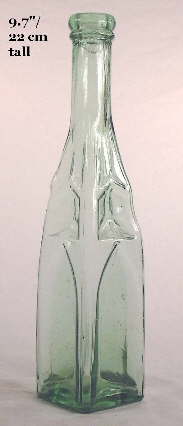 Square:
The gothic peppersauce bottle pictured in the upper left corner of this
section
is a square gothic sauce dating from the 1850s to mid-1860s time period based on
diagnostic features including an improved or iron pontil mark on the base
and a
key mold base conformation.
This example is typical of the design popular during the 1850 through 1880
period. Click on
base view to see an image of this bottles base showing the very
distinct iron or improved pontil scar. The
picture to the right is of a bit later version of a square gothic
pepper sauce (ca. 1880 to 1885 based on the context of where excavated)
which has a crudely applied double ring finish (the typical finish on most
gothic sauces), post-bottom mold conformation, no evidence of a pontil scar nor of any
mold air venting. This particular gothic sauce was made 20+ years
after the example above with the only noticeable difference (besides
subtle design differences) is that it is a bit narrower in diameter. The
author has noted with both the square and hexagonal shapes a
distinct tendency towards narrower bodied bottles as the 19th century progressed.
In addition, the square styles appear to have largely fallen out of favor
by the early 1890s
(discussed below) though were being made by at least one bottle maker until 1898
(Hagerty Brothers 1898). Click on the following links for more images of
the gothic pepper sauce bottle to the right:
base view;
close-up of the neck and applied finish.
(This bottle is also the square example in the base image above.) Square:
The gothic peppersauce bottle pictured in the upper left corner of this
section
is a square gothic sauce dating from the 1850s to mid-1860s time period based on
diagnostic features including an improved or iron pontil mark on the base
and a
key mold base conformation.
This example is typical of the design popular during the 1850 through 1880
period. Click on
base view to see an image of this bottles base showing the very
distinct iron or improved pontil scar. The
picture to the right is of a bit later version of a square gothic
pepper sauce (ca. 1880 to 1885 based on the context of where excavated)
which has a crudely applied double ring finish (the typical finish on most
gothic sauces), post-bottom mold conformation, no evidence of a pontil scar nor of any
mold air venting. This particular gothic sauce was made 20+ years
after the example above with the only noticeable difference (besides
subtle design differences) is that it is a bit narrower in diameter. The
author has noted with both the square and hexagonal shapes a
distinct tendency towards narrower bodied bottles as the 19th century progressed.
In addition, the square styles appear to have largely fallen out of favor
by the early 1890s
(discussed below) though were being made by at least one bottle maker until 1898
(Hagerty Brothers 1898). Click on the following links for more images of
the gothic pepper sauce bottle to the right:
base view;
close-up of the neck and applied finish.
(This bottle is also the square example in the base image above.)
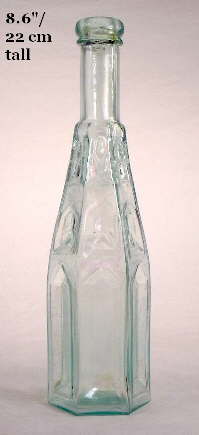 Hexagonal:
The other common conformation for gothic peppersauce bottles was
six-sided/hexagonal as portrayed by the gothic sauce bottle to the left.
This particular bottle lacks a pontil scar on the base (which has the
embossed letter "S" as shown in the base view image above right)
though has a crudely applied double
ring finish,
key base mold blown, and no evidence of mold air venting. It
dates firmly from the mid-1860s as bottles blown in the
same mold - based on a close examination of the precise embossing
details of the "S" - were salvaged from the Steamship Republic©
which sank off the coast of Georgia in late October of 1865 (Gerth pers.
comm. 2007). Given that the lifespan of a heavily used mold for a
popular generic style bottle type like this was likely just a few years, one can be confident
that this bottle dates from the mid-1860s. Click
close-up of the upper embossing pattern, neck and finish to see these
features. Hexagonal:
The other common conformation for gothic peppersauce bottles was
six-sided/hexagonal as portrayed by the gothic sauce bottle to the left.
This particular bottle lacks a pontil scar on the base (which has the
embossed letter "S" as shown in the base view image above right)
though has a crudely applied double
ring finish,
key base mold blown, and no evidence of mold air venting. It
dates firmly from the mid-1860s as bottles blown in the
same mold - based on a close examination of the precise embossing
details of the "S" - were salvaged from the Steamship Republic©
which sank off the coast of Georgia in late October of 1865 (Gerth pers.
comm. 2007). Given that the lifespan of a heavily used mold for a
popular generic style bottle type like this was likely just a few years, one can be confident
that this bottle dates from the mid-1860s. Click
close-up of the upper embossing pattern, neck and finish to see these
features.
Variations of the gothic style were in use for an extensive period and appear to
not have begun to disappear until the advent of bottle making
machines during the early 20th century and even lingered into the early
1920s on bottles which may have been machine-made
(Obear-Nester Co. 1922). It should be noted that all of the later listings
of the gothic style found in glass making catalogs are of
the hexagonal shape; the square types appear to have virtually disappeared
during the 1890s (Whitall Tatum & Co. 1880, 1892, 1896; Hagerty
Brothers 1898; Whitney Glass Works
1904; Illinois Glass Co. 1899,1911; Obear-Nester Co. 1922). Click
IGCo. 1906 catalog - pages 204-205 to see an illustration (lower left)
of a gothic pepper sauce from the Illinois Glass Company 1906 catalog
which is the same mold as offered in 1911 (Illinois Glass Co. 1906, 1911).
These later mouth-blown hexagonal examples have tooled finishes, exhibit
mold air venting marks, and were made in cup-bottom molds (Spude
et al. 2006). (Example noted below.)
Other images of gothic style sauce bottles are
available by clicking on the following links. This helps show
a bit of the diversity of shape found in these bottles:
-
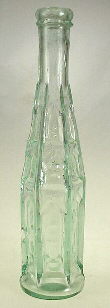 Early
20th century gothic peppersauce - This
is an typical example of the later mouth-blown hexagonal pepper sauce
bottle which was likely made sometime between the 1890s and 1910s.
It is 8.5" tall, has a tooled double ring finish, and was blown in a
cup-bottom mold; presence of air venting is unknown (photos from eBay®).
This shows the slight but distinctly narrower profile typical of the
later hexagonal gothic pepper sauces noted earlier and is virtually
identical to the Obear-Nester Glass Co. example illustrated (and
discussed) below. Click on the following links to view more images
of this bottle:
base view showing a cup-bottom mold conformation and an embossed "K"
which might indicate production by the Kearns-Gorsuch Bottle
Co. whose 1916 catalog showed an identical item;
view of the decorative elements on the lower body;
view of the decorative elements of the shoulder;
view of the upper shoulder, neck and finish (Kearns-Gorsuch Bottle
Co. 1916). Early
20th century gothic peppersauce - This
is an typical example of the later mouth-blown hexagonal pepper sauce
bottle which was likely made sometime between the 1890s and 1910s.
It is 8.5" tall, has a tooled double ring finish, and was blown in a
cup-bottom mold; presence of air venting is unknown (photos from eBay®).
This shows the slight but distinctly narrower profile typical of the
later hexagonal gothic pepper sauces noted earlier and is virtually
identical to the Obear-Nester Glass Co. example illustrated (and
discussed) below. Click on the following links to view more images
of this bottle:
base view showing a cup-bottom mold conformation and an embossed "K"
which might indicate production by the Kearns-Gorsuch Bottle
Co. whose 1916 catalog showed an identical item;
view of the decorative elements on the lower body;
view of the decorative elements of the shoulder;
view of the upper shoulder, neck and finish (Kearns-Gorsuch Bottle
Co. 1916).
Dating summary/notes: Gothic style sauce
bottles are most commonly associated with historic sites that date from
the period spanning the late 1840s to early 1850s through the 1880s; the gothic sauce bottles
pictured here are typical of that era (Deiss 1981). Glass color is almost always aqua though on occasion other colors may be encountered from
colorless or light amethyst (manganese dioxide de-colorized glass) to deep
greens or blues (Switzer 1974; McKearin & Wilson 1978; Hawley 1998; Gerth 2006). The gothic style gradually
became less common/popular, as indicated by glass makers catalogs and empirical
observations, from the early to mid-1890s on though were known to be
produced until at least 1922 (Whitall, Tatum 1880,1892,1902,1909; Whitney
Glass 1904; Cumberland Glass 1911; Illinois Glass Co. 1899,1911;
Obear-Nester Glass Co. 1922). The following is a summary of some key
date ranges for two classes of gothic sauce bottles:
-
Square and hexagonal examples first appeared in
the late 1840s to possibly early 1850s (Deiss 1981).
- Pontil scarred examples (glass-tipped,
blowpipe, and iron pontil scars) date from the above noted origination
time to the American Civil
War period. After that point (approximately 1860-1865) these bottles
are virtually all "smooth base", i.e., lacking a pontil scar, indicating
they were
finished while being held by a
snap case tool (Switzer 1974;
Russell 1998; Gerth pers. comm. 2007).
-
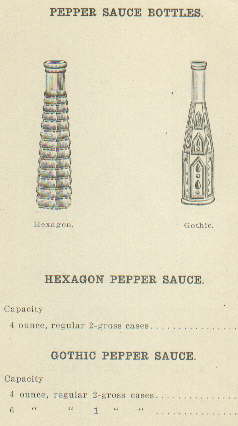 Square examples appear to have largely disappeared by
the early to mid-1890s with some made as late as 1898
(Hagerty Brothers 1898). All square examples studied by the author
have had applied finishes indicating that this style was unusual by the
mid to late 1880s. Bottle makers catalogs after the late 1890s
only
list hexagonal designs, if they list any gothic design sauces. Square examples appear to have largely disappeared by
the early to mid-1890s with some made as late as 1898
(Hagerty Brothers 1898). All square examples studied by the author
have had applied finishes indicating that this style was unusual by the
mid to late 1880s. Bottle makers catalogs after the late 1890s
only
list hexagonal designs, if they list any gothic design sauces.
- Hexagonal examples were mouth-blown produced at
least as late as 1911 and possibly even into the 1920s (Cumberland Glass
Co. 1911; Illinois Glass Co. 1911; Kearns-Gorsuch Bottle Co. 1916; Obear-Nester Glass Co. 1922). Those made
prior to the late 1880s have applied finishes; those after that
time (1890s and later) typically have tooled finishes. Early 20th century
examples are not uncommon in colorless or light amethyst glass (Rinker
1968; empirical observations). Early 20th century examples made by the Illinois
Glass Co. are often based marked with
I. G. Co. and were virtually identical to the example in the
illustration to the right (Obear-Nester Co. 1922; Zumwalt 1980; empirical observations).
- The latest hexagonal gothic sauce bottles were
likely machine-made, though examples have not been observed
by the author. The example listed in the 1922 Obear-Nester
Glass Co. catalog (illustration to the right) was
likely made by machine given the late date, though mouth-blown
production can
not be ruled out. The illustration shows the typical type of
relatively narrow hexagonal gothic pepper sauce bottles made by various
glass makers from the 1890s through the first couple decades of the 20th
century. In fact, that illustrated design conformation - having
embossed decorative features within the tall arched lower panel - is typical of the gothic
sauce bottles made during the 1890s through 1910s to early 1920s era, including the
mouth-blown items noted in the previous point. Most gothic sauce
bottles produced before the 1890s were conformed like the bottles pictured
earlier in this section (Illinois Glass Co. 1899, 1906, 1911;
Kearns-Gorsuch Bottle Co. 1916; Obear-Nester Co. 1922). (Note:
This illustration also shows [bottle on left] Obear-Nester's
horizontally ribbed "hexagon pepper sauce" bottle offering; the subject
of the next section below.)
As noted earlier, there was a trend in gothic sauce
bottles for the diameter of the bottles - both square and hexagonal - to
narrow a bit over time from the 1870s to about 1900. However, this
is a feature that is only easily apparent after examining a large number
of these type bottles and should simply be used as one of several physical
features to consider when estimating the manufacturing date of this type.
Generally speaking, the dating of
these type bottles based on manufacturing related diagnostic features
follows quite well the guidelines presented throughout this website and
summarized on the
Bottle Dating page; see that page for more information. |
|
Ribbed styles
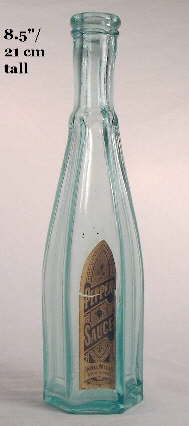 This moderately variable category of sauce bottles is unified by the fact
that the bottles have some type of molded decorative body features dominated by variously
detailed and oriented ridges or ribbing. These bottles primarily
contained various types of pepper sauce (aka peppersauce - one word)
though some were used for foods like ketchup, vinegar and likely other
semi-liquid food products (Switzer 1974; Zumwalt 1980). This moderately variable category of sauce bottles is unified by the fact
that the bottles have some type of molded decorative body features dominated by variously
detailed and oriented ridges or ribbing. These bottles primarily
contained various types of pepper sauce (aka peppersauce - one word)
though some were used for foods like ketchup, vinegar and likely other
semi-liquid food products (Switzer 1974; Zumwalt 1980).
All do share a general similarity of overall
conformation of being a "sauce-like" tall and narrow, usually a
capacity of 12 oz. or less, and typically (but not always) have a
relatively narrow bore and double
ring finish. One should be aware that there is a lot form and
decorative variety within this category not specifically covered by the
pictured bottles, though those discussed in the following are
commonly encountered designs (Zumwalt 1980). It should also be noted
that ketchup bottles often have vertical body ribbing and grade
into this category somewhat, though ketchup bottles tend to have
a different overall conformation and usually a different type finish, i.e., commonly
have external screw thread finishes, at least from the 1890s and later. (Ketchup bottles are covered in
the next section.)
Vertically ribbed:
Tall, relatively narrow sauce bottles with varying types of vertical ribs,
ridging or fluting were a
very common conformation from as early as the late 1840s
or early 1850s well into the early 20th century (Switzer 1974; Zumwalt 1980). Mouth-blown vertically ribbed
sauce bottles were typically made of aqua glass, though colorless or light amethyst (manganese
dioxide decolorized glass) examples are fairly common and deeper greens and blues occasionally
seen. Machine-made vertically ribbed sauce bottles - though not
specifically discussed here - exist and lean strongly towards being
dominated by colorless glass like the majority of 20th century,
machine-made food bottles and jars (Zumwalt 1980).
The
common, vertically ribbed sauce bottle pictured above is of
late 19th century origin and is hexagonal in cross-section. It has the original label
(with a peaked "gothic" type look) noting that it contained
"Pepper Sauce" and was produced and/or bottled by the India Mills
of New York. Nothing is really known about this company except that
it was located at 534 Washington St. in New York City (Zumwalt 1980).
However, this vertically ribbed style (and similar variations) were certainly used by many different sauce
producing companies and made by many different glass companies
during the era from the 1880s to 1910s.
This particular example has a tooled double ring finish and was blown in a
post-bottom mold though has no obvious air venting marks indicating a likely 1885-1895
manufacturing date range. Click on the following links for more images of this
bottle:
base view;
close-up of the label;
close-up of the shoulder, neck, and
applied finish.
 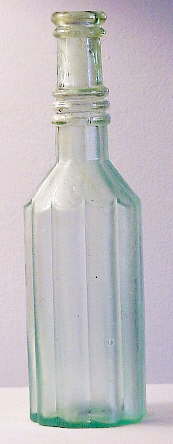 The picture to the right is
of a
typical early vertically ribbed/fluted (10-ribs) sauce bottle that was a
very common and popular style from the 1850s through at least the early 1900s
(Whitall Tatum 1880; Alther 1909; empirical observations). (Photo courtesy of David Whitten).
The pictured example also has three horizontal
rings on the neck which was a common stylistic feature for this class of
vertically ribbed sauce bottles. This example has an
applied double ring finish, lacks evidence of mold air venting,
and is not pontil scarred on the base which is embossed
with S. G. W. LOU. KY. indicating manufacture by the Southern Glass Works
of Louisville, KY. who used this mark from 1877 to about 1885 (Whitten 2005b;
this reference is available on this website by
clicking
HERE). The picture to the right is
of a
typical early vertically ribbed/fluted (10-ribs) sauce bottle that was a
very common and popular style from the 1850s through at least the early 1900s
(Whitall Tatum 1880; Alther 1909; empirical observations). (Photo courtesy of David Whitten).
The pictured example also has three horizontal
rings on the neck which was a common stylistic feature for this class of
vertically ribbed sauce bottles. This example has an
applied double ring finish, lacks evidence of mold air venting,
and is not pontil scarred on the base which is embossed
with S. G. W. LOU. KY. indicating manufacture by the Southern Glass Works
of Louisville, KY. who used this mark from 1877 to about 1885 (Whitten 2005b;
this reference is available on this website by
clicking
HERE).
The
almost identical, ringed neck, vertically ribbed/fluted sauce bottle to the left is embossed on the
shoulder with WELLS, MILLER & PROVOST which was a
successful New York City food packing firm established in 1841 by John
B. Wells. (Photo courtesy of Glass Works Auctions.) Ebenezer
Miller and Stephen
Provost joined with Wells by 1842 and 1845, respectively, and operated
under their
three names until late summer of 1852 when Miller died (Zumwalt 1980;
Caniff 2021). This particular
bottle has a crudely applied one-part extract type
finish (more or less), blowpipe pontil scarred base, and was hinge mold
blown with certainly no evidence of mold air venting. (Note: This author has never
observed a pontil scarred, mold air vented bottle.) These attributes
are consistent with a
manufacture during the late 1840s to early 1860s, although the above
company dates would narrow that dating to 1845 to 1852 (or possibly 1853
if that mold was still being used beyond Mr. Miller's demise). One of these bottles with an
original label noted that it contained "tomato catsup" and similar bottles
from this company have been recorded in cobalt blue and deep green, though the vast
majority are aqua (Zumwalt 1980; empirical observations).
Pickle bottles from this company (with a few name changes over the years) were also excavated from both the
steamships Arabia and Bertrand which sank in the
Missouri River in 1856 and 1865, respectively (Switzer 1974; Hawley 1998).
This gives some indication of how commonly used these bottles were during the
mid-19th century.
Although the style was most popular during the era noted (1850s to 1880s)
they were made by at least one glassmaker in the early 1900s
as they are listed in the Robert J. Alther 1909 glassware catalog
as a "fluted pepper sauce" (Alther 1909; empirical
observations). Click
Alther 1909 catalog page 55 to view the page from the catalog that
shows their version of the bottle which appear identical to the examples
pictured above, including the vertically fluted body ribs and three
tightly grouped horizontal rings on the neck (Alther 1909). Although the author
has not personally seen an example with diagnostic features indicating an early
20th century production, it is possible that the vertically ribbed pepper
sauce in the "other images" grouping below may be from as late as the very
early 1900s. (This photo and a description of the bottle was
provided by a user of this site in early 2010.)
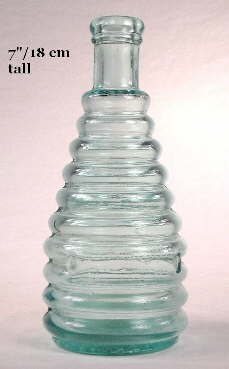 Horizontally ribbed: Distinct horizontal ribbing
was also a very common conformation for a wide variety of sauce bottles from
at least as early as the 1870s until well into the 20th century. Many
types of sauce bottles fit into this category with only a few covered here;
users should be
aware that this category has a wide range of types and variations. The
binding feature here is that these bottles have distinct horizontal body
ribbing, usually held no more than 12 to 16 oz. (often much less), and
typically have double ring finishes - at least through the mouth-blown
era and into the 1920s with machine-made items (empirical observations). Horizontally ribbed: Distinct horizontal ribbing
was also a very common conformation for a wide variety of sauce bottles from
at least as early as the 1870s until well into the 20th century. Many
types of sauce bottles fit into this category with only a few covered here;
users should be
aware that this category has a wide range of types and variations. The
binding feature here is that these bottles have distinct horizontal body
ribbing, usually held no more than 12 to 16 oz. (often much less), and
typically have double ring finishes - at least through the mouth-blown
era and into the 1920s with machine-made items (empirical observations).
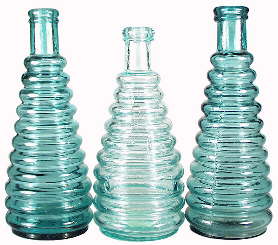 The
so-called "beehive" sauce bottles pictured to the left and
right were used by the E. R. Durkee & Co. (New York) and are
embossed on the base as such. (Photo to the right courtesy of Glass Works
Auctions.) Click
Durkee sauce base to see an image of the base. The pictured bottles range from 7" to 7.5"
tall and may have tooled or applied double ring finishes and evidence (or
not) of mold air venting depending on the time of manufacture. These are not
narrow bodied like the other sauces pictured here though there are other
obvious similarities. (As emphasized throughout this website, this is
yet another example of the fact that in all things connected with bottle
identification, there are virtually always exceptions.) A few other companies utilized
bottles of this style from at least the 1880s to well into the 1910s and
possibly later, although the vast majority of the beehive sauce bottles
encountered are from Durkee (Zumwalt 1980; empirical observations). The
so-called "beehive" sauce bottles pictured to the left and
right were used by the E. R. Durkee & Co. (New York) and are
embossed on the base as such. (Photo to the right courtesy of Glass Works
Auctions.) Click
Durkee sauce base to see an image of the base. The pictured bottles range from 7" to 7.5"
tall and may have tooled or applied double ring finishes and evidence (or
not) of mold air venting depending on the time of manufacture. These are not
narrow bodied like the other sauces pictured here though there are other
obvious similarities. (As emphasized throughout this website, this is
yet another example of the fact that in all things connected with bottle
identification, there are virtually always exceptions.) A few other companies utilized
bottles of this style from at least the 1880s to well into the 1910s and
possibly later, although the vast majority of the beehive sauce bottles
encountered are from Durkee (Zumwalt 1980; empirical observations).
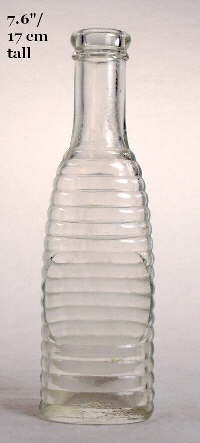 The
horizontally ribbed sauce pictured to the left is an early machine-made
item that also had virtually identical mouth-blown counterparts.
These were called "ring pepper sauce" or "oval ring pepper sauce" bottles
by the likely dozens of different early 20th century glass makers that
produced the style. This particular example has a the "I in a diamond"
maker's mark for the Illinois Glass Company (Alton, IL.) and likely
dates from the mid-1910s as this style was shown in their 1911 catalog but
not in the 1920 or 1925 editions. This oval (in cross-section) style was
popular from the late 1890s through at least the late 1920s and early
1930s (Illinois Glass 1899, 1911, 1920, 1925; Cumberland Glass 1911; Fairmount
Glass ca. 1930). Click on the following links to view more images
of this bottle:
base view
vaguely showing the maker's mark
for the Illinois Glass Co.; side view;
close-up of the shoulder, neck, and
finish. Very similar looking ringed peppersauce bottles were also
made during the same era (1890s through 1920s) that were round ("round
ring pepper sauce") and square ("square ring pepper sauce") in
cross-section instead of oval (Illinois Glass 1906; Cumberland Glass 1911;
Obear-Nester Glass 1922). The
horizontally ribbed sauce pictured to the left is an early machine-made
item that also had virtually identical mouth-blown counterparts.
These were called "ring pepper sauce" or "oval ring pepper sauce" bottles
by the likely dozens of different early 20th century glass makers that
produced the style. This particular example has a the "I in a diamond"
maker's mark for the Illinois Glass Company (Alton, IL.) and likely
dates from the mid-1910s as this style was shown in their 1911 catalog but
not in the 1920 or 1925 editions. This oval (in cross-section) style was
popular from the late 1890s through at least the late 1920s and early
1930s (Illinois Glass 1899, 1911, 1920, 1925; Cumberland Glass 1911; Fairmount
Glass ca. 1930). Click on the following links to view more images
of this bottle:
base view
vaguely showing the maker's mark
for the Illinois Glass Co.; side view;
close-up of the shoulder, neck, and
finish. Very similar looking ringed peppersauce bottles were also
made during the same era (1890s through 1920s) that were round ("round
ring pepper sauce") and square ("square ring pepper sauce") in
cross-section instead of oval (Illinois Glass 1906; Cumberland Glass 1911;
Obear-Nester Glass 1922).
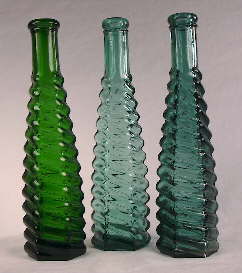 Spiral: This style falls
halfway between the two styles noted above in that the ribs spiral down (or
up depending on perspective) the bottle with the overall "look" visually
more similar to the horizontally ribbed styles than the
vertically ribbed. This style is typified by the three differently colored
sauce bottles pictured to the right. Spiral: This style falls
halfway between the two styles noted above in that the ribs spiral down (or
up depending on perspective) the bottle with the overall "look" visually
more similar to the horizontally ribbed styles than the
vertically ribbed. This style is typified by the three differently colored
sauce bottles pictured to the right.
The pictured bottles to the right (7.5" to 8"
tall) are
commonly encountered on late 19th to early 20th century historic sites
and are embossed with S & P. PAT. APP. FOR on the base. The
S. & P. is for Stickney & Poor, a very successful Boston producer
of "Mustards, Spices, Extracts, &c." during most of the 19th century and
apparently into the 20th (Zumwalt 1980). These bottles have tooled
double ring finishes (with the upper portion distinctly larger than the
lower portion) and were blown in a cup-base mold which likely had air venting (although
evidence of air venting is lost in the heavily decorated body styling) -
all attributes
indicating manufacture between the 1880s and early 1910s. These
bottles were neck labeled since labels could not adhere well to the lumpy
body; click
Stickney & Poor label to see an image of part of the neck label noting
the company name. All three
of the pictured bottles were produced in the same mold and show the slight differences
in neck length (bottles are about 1/2" different in height) common with mouth-blown bottles depending
on where the bottle was cracked-off from the blowpipe.
Other images of ribbed style sauce bottles are
available by clicking on the following links. This helps show
a bit of the diversity of shape found in these style bottles:
-
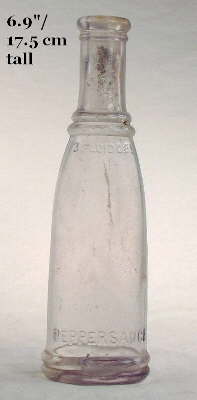 PEPPERSAUCE - This is an early 20th century, mouth-blown pepper
sauce bottle that is embossed with 3 FLUID OZS / PEPPERSAUCE on
one semi-flattened side. This is a variation of the oval (in
cross-section), horizontally ringed peppersauce style that was very
popular from the early 1900s to 1930s, though this example only has two
rings at the shoulder and two above the heel. It has a tooled
double ring finish, was blown in a cup-bottom mold, and has multiple mold air
venting marks including on the base which is a strong sign of production
after 1900 into at least the early 1920s. It was made of colorless glass which has a
slight amethyst tint indicating de-colorization with
manganese dioxide which was most commonly used between the 1880s and
late 1910s (Giarde 1989). Click on the following links to view
more images of this bottle:
base view;
close-up of the shoulder, neck and finish showing the upper body
rings and the location where the side mold seam disappears. PEPPERSAUCE - This is an early 20th century, mouth-blown pepper
sauce bottle that is embossed with 3 FLUID OZS / PEPPERSAUCE on
one semi-flattened side. This is a variation of the oval (in
cross-section), horizontally ringed peppersauce style that was very
popular from the early 1900s to 1930s, though this example only has two
rings at the shoulder and two above the heel. It has a tooled
double ring finish, was blown in a cup-bottom mold, and has multiple mold air
venting marks including on the base which is a strong sign of production
after 1900 into at least the early 1920s. It was made of colorless glass which has a
slight amethyst tint indicating de-colorization with
manganese dioxide which was most commonly used between the 1880s and
late 1910s (Giarde 1989). Click on the following links to view
more images of this bottle:
base view;
close-up of the shoulder, neck and finish showing the upper body
rings and the location where the side mold seam disappears.
-
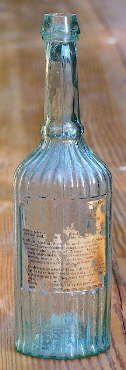 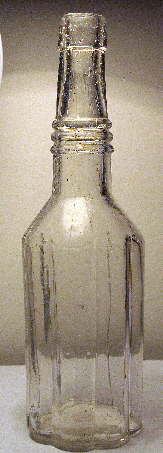 Vertically
ribbed "cure" sauce bottle (aqua bottle to far right)
- This bottle is an early style that was
used for various sauces (Zumwalt 1980) though this example still retains
a fragmental label noting the contents would treat or cure various
ailments, i.e., it appears to have contained a patent medicine!
The bottle body and shoulder is vertically ribbed with a horizontal ring
on the lower neck, has a blowpipe pontil scar on the base, crudely
applied two-part mineral type finish, and was blown in a post-bottom mold
which almost certainly was not air vented given the likely date of
manufacture of the 1850s or early 1860s. This item could simply be
an example of bottle re-use, having started its life as a sauce bottle,
or it could have been purchased new to contain medicine - there is no
way to know for sure. Click on the following links for more images
of this bottle:
base view showing the blowpipe style pontil scar;
close-up of the shoulder, neck and finish;
close-up of the fragmental label showing the medicinal claims.
(Photos from eBay®.) This is yet
another example of how one can not be 100% sure what a bottle actually
contained unless pertinent embossing or the original labeling is
present. It is likely, however, that the vast majority of these
type bottles were indeed used for sauces. Vertically
ribbed "cure" sauce bottle (aqua bottle to far right)
- This bottle is an early style that was
used for various sauces (Zumwalt 1980) though this example still retains
a fragmental label noting the contents would treat or cure various
ailments, i.e., it appears to have contained a patent medicine!
The bottle body and shoulder is vertically ribbed with a horizontal ring
on the lower neck, has a blowpipe pontil scar on the base, crudely
applied two-part mineral type finish, and was blown in a post-bottom mold
which almost certainly was not air vented given the likely date of
manufacture of the 1850s or early 1860s. This item could simply be
an example of bottle re-use, having started its life as a sauce bottle,
or it could have been purchased new to contain medicine - there is no
way to know for sure. Click on the following links for more images
of this bottle:
base view showing the blowpipe style pontil scar;
close-up of the shoulder, neck and finish;
close-up of the fragmental label showing the medicinal claims.
(Photos from eBay®.) This is yet
another example of how one can not be 100% sure what a bottle actually
contained unless pertinent embossing or the original labeling is
present. It is likely, however, that the vast majority of these
type bottles were indeed used for sauces.
-
Later vertically ribbed pepper sauce or catsup bottle (colorless
bottle to the immediate left above) - This is late example of the
vertically ribbed/fluted pepper sauce style bottle. Diagnostic
manufacturing related features on this bottle which point towards a
later manufacture (1895 to the early
1910s) for this style is the colorless glass, cup-bottom mold production,
7 air venting marks scattered around shoulder at the top of most of the
ribs (click
shoulder close-up to see one of the vent marks pointed out), and the
tooled finish. The oil finish on this bottle, instead of the
usual double ring, indicates it may have been used for catsup instead of
pepper sauce, though without any identifying embossing or the original
label - of which this bottle has neither - it is impossible to tell for
sure. Click
base image to see such which shows the M or W marking which may or
may not be a makers marking; probably the latter. (Photos courtesy
of Janis Scalone.)
-
More to be added in the future...
Dating summary/notes: Given the wide span of
production, the dating of this large class of sauce bottles can not be
done based on shape alone. Instead, it must be done based on
manufacturing related diagnostic features and/or through research of the
historical record when possible. The latter is usually not possible unless the example
has the original labels or is embossed, a rare occurrence. Generally
speaking, the dating of
these type bottles based on manufacturing related diagnostic features
follows quite well the guidelines presented throughout this website and
summarized on the
Bottle Dating page; see that page for more information.
|
|
Ketchup (catsup) styles
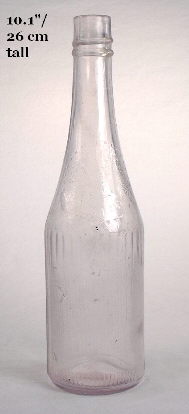 Tomato
ketchup/catsup (both spellings are correct and used interchangeably here)
was contained in a moderately varied array of different shaped bottles, though there
are some styles that are strongly identified with the product. For
example, the bottle to the left is a classic and distinctly shaped style used for ketchup for a very long period
of time. Generally speaking,
ketchup bottles are relatively tall and narrow (a typical height of at least
3 times the body or base diameter) and have a moderately narrow mouth or bore for
the size of the bottle. The most common styles (like most of the
examples pictured here) also have a long gradually
tapering shoulder to neck portion that is distinctly taller than the body
section below it. Earlier
examples (ca. 1890 and before), like most other type bottles, had cork accepting finishes
of one type or another.
However, from the
1890s and later, externally threaded finishes with metal screw caps became
increasing the most common closure/finish combination for ketchup. Most
styles also had some type of molded body and/or shoulder features like
vertical body ribs (image to the left; common on 1890s to
1920s bottles) or vertical body side panels (typically 8 sides or more) as
shown by the bottles pictured here. Flat panels on the body
are very typical of bottles from about 1910 to at least the mid-20th
century (and even today on glass ketchup bottles still being used; most
ketchup now comes in plastic). Tomato
ketchup/catsup (both spellings are correct and used interchangeably here)
was contained in a moderately varied array of different shaped bottles, though there
are some styles that are strongly identified with the product. For
example, the bottle to the left is a classic and distinctly shaped style used for ketchup for a very long period
of time. Generally speaking,
ketchup bottles are relatively tall and narrow (a typical height of at least
3 times the body or base diameter) and have a moderately narrow mouth or bore for
the size of the bottle. The most common styles (like most of the
examples pictured here) also have a long gradually
tapering shoulder to neck portion that is distinctly taller than the body
section below it. Earlier
examples (ca. 1890 and before), like most other type bottles, had cork accepting finishes
of one type or another.
However, from the
1890s and later, externally threaded finishes with metal screw caps became
increasing the most common closure/finish combination for ketchup. Most
styles also had some type of molded body and/or shoulder features like
vertical body ribs (image to the left; common on 1890s to
1920s bottles) or vertical body side panels (typically 8 sides or more) as
shown by the bottles pictured here. Flat panels on the body
are very typical of bottles from about 1910 to at least the mid-20th
century (and even today on glass ketchup bottles still being used; most
ketchup now comes in plastic).
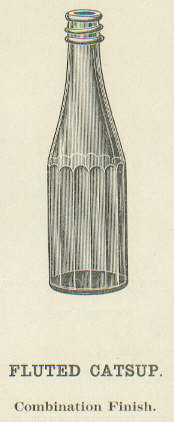 Ketchup
bottles were a standard offering from most bottle producing glass
companies as evidenced by most late 19th to mid-20th century bottle makers
catalogs. Sizes varied from a few ounces up to at least a quart
(Whitall Tatum & Co. 1880; Illinois Glass Company 1903, 1920; Obear-Nester
Glass 1922; Owens-Illinois Glass Co. 1952). The illustration to the right is from the
Obear-Nester Glass Co. (St. Louis, MO.) 1922 bottle catalog
and was offered in only the 14 ounce size - a typical size for
ketchup bottles. This one notes its availability with an interesting "combination
finish" which would accept a screw cap, a crown cap, and/or likely a "Goldy" cap.
Click
Goldy closure to view a description of this type closure and finish
on the Bottle Closures page. Ketchup
bottles were a standard offering from most bottle producing glass
companies as evidenced by most late 19th to mid-20th century bottle makers
catalogs. Sizes varied from a few ounces up to at least a quart
(Whitall Tatum & Co. 1880; Illinois Glass Company 1903, 1920; Obear-Nester
Glass 1922; Owens-Illinois Glass Co. 1952). The illustration to the right is from the
Obear-Nester Glass Co. (St. Louis, MO.) 1922 bottle catalog
and was offered in only the 14 ounce size - a typical size for
ketchup bottles. This one notes its availability with an interesting "combination
finish" which would accept a screw cap, a crown cap, and/or likely a "Goldy" cap.
Click
Goldy closure to view a description of this type closure and finish
on the Bottle Closures page.
The mouth-blown ketchup bottle pictured to the above left is a
very typical general shape for packaging this product during the late 19th through
much of the 20th century; it is not that much different than the shape
used today for glass bottled ketchup (somewhat of a rarity in the U. S.
since most is now packaged in plastic bottles). This example is embossed
on the shoulder - inside a circular "medallion" - with PREFERRED
STOCK CATSUP / A & L (monogram) / EXTRA QUALITY. The A & L stands
for Allen & Lewis, a large regional "Wholesale Dealer in Staple and
Fancy Groceries" located in Portland, Oregon. "Preferred Stock" was
a proprietary brand name used by the company for many of their products. (See
the labeled olive oil bottle later on this page.) Allen & Lewis
began business in the early days of Portland in 1861 and continued until at least 1917 and
probably much later (Zumwalt 1980). The pictured bottle dates from
the 1900 to 1915 era based on the
"improved" tooled external screw thread
finish (called a "screw top tool finish" by glassmakers), multiple mold air venting marks on the shoulder and possibly in
the embossing pattern, a faint amethyst tint to the glass, and cup-bottom mold
production - all of which point towards the first two decades of the 20th
century (Fairmount Glass Works 1910).
Click on the following links to view more images of this bottle:
reverse view showing the ribbing;
close-up of the shoulder, neck and finish;
close-up of the shoulder showing
(faintly) the embossing;
close-up of the finish showing the "improved
tooled finish" with the mold seam ending point indicated.
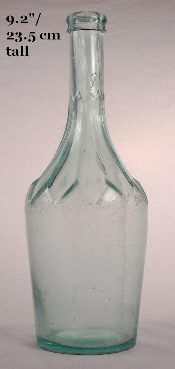 The
likely ketchup bottle pictured to the left is representative of the
fancier earlier sauce bottle
styles and an example that
most likely dates from about 1875-1885. It has a relatively crudely applied double
ring finish, lacks evidence of mold air venting, and exhibits some other minor
manufacturing crudeness though was blown in a cup-bottom mold which was a
bit unusual for this
early of a bottle and given its moderate size. This style could well have held other types of sauce
(i.e., pepper sauce) though bulbous bodied, ornate styles similar to this were
frequently noted in bottle makers catalogs as intended for ketchup;
they were even called "decanter
catsups" by some (Whitall Tatum & Co. 1879,
1909; Hagerty Bros. 1898; Illinois Glass Co. 1903, 1911; Alther 1909).
Click on the following links to view more images of this sauce bottle:
base view;
close-up of the shoulder, neck, and finish.
A very similar "decanter catsup" was offered by Robert J.
Alther (San Francisco, CA.) in their 1909 catalog; click
Alther 1909 catalog page 55 to view this item. The
likely ketchup bottle pictured to the left is representative of the
fancier earlier sauce bottle
styles and an example that
most likely dates from about 1875-1885. It has a relatively crudely applied double
ring finish, lacks evidence of mold air venting, and exhibits some other minor
manufacturing crudeness though was blown in a cup-bottom mold which was a
bit unusual for this
early of a bottle and given its moderate size. This style could well have held other types of sauce
(i.e., pepper sauce) though bulbous bodied, ornate styles similar to this were
frequently noted in bottle makers catalogs as intended for ketchup;
they were even called "decanter
catsups" by some (Whitall Tatum & Co. 1879,
1909; Hagerty Bros. 1898; Illinois Glass Co. 1903, 1911; Alther 1909).
Click on the following links to view more images of this sauce bottle:
base view;
close-up of the shoulder, neck, and finish.
A very similar "decanter catsup" was offered by Robert J.
Alther (San Francisco, CA.) in their 1909 catalog; click
Alther 1909 catalog page 55 to view this item.
In general, like with some
other bottles styles (e.g., liquor cylinders) the earlier bottles
(mid-19th century) used for catsup tended to be wider in the body than
later (post-1880s) ketchup bottles, although there were (of course)
exceptions. The steamboat Bertrand cargo from 1865 had three clearly identified
different types of catsup bottles which were tall (>11") and slender with
vertical flat body facets (Switzer 1974; empirical observations). These bottles look to be
the
precursor style to the early 20th century examples discussed here.
The point here is that there was a lot of variety in shapes used for ketchup,
particularly during the period from the 1840s to the 1890s. By the
latter
time styles began to become a bit more uniform though
there was still some variety; see pages 200-205 of the 1906 Illinois Glass
Company catalog found on this website at this link:
1906 Illinois Glass Company Bottle Catalog.
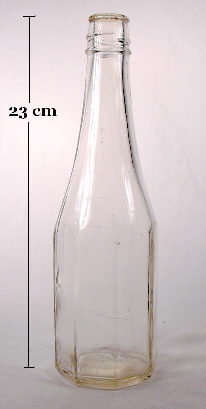  The
machine-made, 8-sided ketchup bottle pictured to the right was produced by the Illinois-Pacific Glass Corporation
(San Francisco, CA.) between 1926 and 1930 for the Heinz®
company for containing ketchup and other sauces including pepper sauces
(Zumwalt 1980; Lockhart et al. 2005d). The base is embossed with H. J.
HEINZ CO. / 255 / IPG (in a triangle) / PATD. Click the
base view to see the base of this bottle showing the embossing and makers
mark. The PATD. refers to
Heinz's
March 28th, 1893
patent for this bottle style; the 255 is Heinz's assigned number
for the style. The company assigned an internal number to all their
scores of patented bottle styles beginning about 1873 (Zumwalt 1980).
This particular bottle was found with a crown cap on it (note rust
staining) as the bead on the rim of this "combination" finish is exactly the right size
for a typical sized crown cap. It is not thought original but
related to a re-use of the bottle as it had several holes punched in it
and was likely re-used as a salt shaker or sprinkle bottle. This
general style of 8-sided catsup bottle was called the "octagon catsup" or
"paneled catsup" by bottle makers (Illinois Glass Co. ca. 1925; Fairmount
Glass Works ca. 1930). The
machine-made, 8-sided ketchup bottle pictured to the right was produced by the Illinois-Pacific Glass Corporation
(San Francisco, CA.) between 1926 and 1930 for the Heinz®
company for containing ketchup and other sauces including pepper sauces
(Zumwalt 1980; Lockhart et al. 2005d). The base is embossed with H. J.
HEINZ CO. / 255 / IPG (in a triangle) / PATD. Click the
base view to see the base of this bottle showing the embossing and makers
mark. The PATD. refers to
Heinz's
March 28th, 1893
patent for this bottle style; the 255 is Heinz's assigned number
for the style. The company assigned an internal number to all their
scores of patented bottle styles beginning about 1873 (Zumwalt 1980).
This particular bottle was found with a crown cap on it (note rust
staining) as the bead on the rim of this "combination" finish is exactly the right size
for a typical sized crown cap. It is not thought original but
related to a re-use of the bottle as it had several holes punched in it
and was likely re-used as a salt shaker or sprinkle bottle. This
general style of 8-sided catsup bottle was called the "octagon catsup" or
"paneled catsup" by bottle makers (Illinois Glass Co. ca. 1925; Fairmount
Glass Works ca. 1930).
NOTE: For a comprehensive list of
Heinz base codes - which indicates the actual use of the bottle - click on
Heinz Base Codes (Word document) or
Heinz Base Codes (PDF file). Code list courtesy of the H. J. Heinz®
Company.
(UPDATE September 2022: Recently John Lord - a ketchup/catsup bottle
collector - revised and reorganized the previously noted list of base
codes which may be of more use to food bottle researchers. He has
graciously made his revised list available; a PDF copy of which is
located at the following link -
Heinz Base Codes Revised 2022.)
Other images of ketchup bottles are
available by clicking on the following links. This helps show
a bit of the diversity of shape found in these bottles:
-
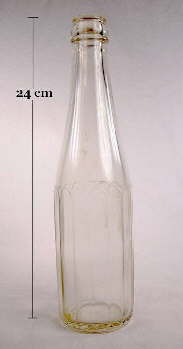 1920s-1930s era catsup bottle - This is 16 narrow paneled body,
machine-made, 1920s to 1930s era catsup bottle made by the Hazel-Atlas
Glass Co. (Wheeling, WV.) that most likely was sealed with a
Goldy cap though it will also accept a standard crown cap. Lief
(1965) noted that the Goldy closure was most popular on catsup bottles
and, though invented in 1897, appeared to have the most popular during
the 1910 to 1950 era, though similar versions are still in some use
today (Lief 1965; empirical observations). This style with the
many body panels was called the "fluted catsup" by some glassmakers as
shown in the illustration earlier in this section (Obear-Nester Glass
Co. 1922; Illinois Glass Co. 1924). 1920s-1930s era catsup bottle - This is 16 narrow paneled body,
machine-made, 1920s to 1930s era catsup bottle made by the Hazel-Atlas
Glass Co. (Wheeling, WV.) that most likely was sealed with a
Goldy cap though it will also accept a standard crown cap. Lief
(1965) noted that the Goldy closure was most popular on catsup bottles
and, though invented in 1897, appeared to have the most popular during
the 1910 to 1950 era, though similar versions are still in some use
today (Lief 1965; empirical observations). This style with the
many body panels was called the "fluted catsup" by some glassmakers as
shown in the illustration earlier in this section (Obear-Nester Glass
Co. 1922; Illinois Glass Co. 1924).
-
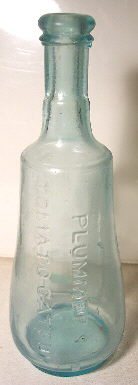 PLUMMER'S / TOMATO CATSUP - This
is one interesting example of the scores of
unusually shaped catsup bottles that were manufactured during the last
half of the 19th century (Zumwalt 1980). This particular example
likely dates from the 1870 to 1880 period
and is 8 1/4" tall, about 2 3/8" in diameter, has an applied double ring
finish (the classic mid to late 19th century sauce bottle finish), and
believed to have no evidence of mold air venting judging from the
flatness of the embossing (image links below). Even though an
unusual conformation it still has an overall shape that "fits" the sauce
bottle category, i.e., tall and relatively narrow, double ring finish,
relatively narrow bore, moderate (8-16 oz.) capacity, and an
attractiveness that catches the customers eye - a common theme with sauce bottles
as illustrated on this page. Of course bottles within the other
types also fit this general description, though if one had an
unembossed bottle that was otherwise identical in form to the
Plummer's, a reasonable conclusion would be that it was likely used as a
sauce bottle. Click on the
following links for more images:
base view;
close-up of the embossing;
close-up of the finish. (Images
from eBay®.) PLUMMER'S / TOMATO CATSUP - This
is one interesting example of the scores of
unusually shaped catsup bottles that were manufactured during the last
half of the 19th century (Zumwalt 1980). This particular example
likely dates from the 1870 to 1880 period
and is 8 1/4" tall, about 2 3/8" in diameter, has an applied double ring
finish (the classic mid to late 19th century sauce bottle finish), and
believed to have no evidence of mold air venting judging from the
flatness of the embossing (image links below). Even though an
unusual conformation it still has an overall shape that "fits" the sauce
bottle category, i.e., tall and relatively narrow, double ring finish,
relatively narrow bore, moderate (8-16 oz.) capacity, and an
attractiveness that catches the customers eye - a common theme with sauce bottles
as illustrated on this page. Of course bottles within the other
types also fit this general description, though if one had an
unembossed bottle that was otherwise identical in form to the
Plummer's, a reasonable conclusion would be that it was likely used as a
sauce bottle. Click on the
following links for more images:
base view;
close-up of the embossing;
close-up of the finish. (Images
from eBay®.)
-
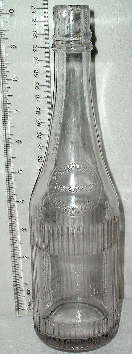 CURTICE BROTHERS CO. / PRESERVERS / ROCHESTER, N.Y. - That is
embossed inside a circle on the shoulder of a standard early 20th
century ketchup bottle that contained their "Blue Label Ketchup."
This example is mouth-blown (similar ones were made by machine also),
almost certainly has air venting, blown in a cup-bottom mold, and has an
improved tooled external threaded finish. Click on the following
links to view more images of this bottle:
base view showing the initials B. B. G. Co. which likely
stands for the Berney-Bond Glass Company (PA.) though that is not
certain (Toulouse 1971; Lockhart pers. comm. 2007);
close-up of the embossing;
close-up of the neck and finish showing the distinctly molded
external screw threads;
image of another dark amethyst example. Curtice Brothers
was a large ketchup and preserves producing firm that began just after
the Civil War and continued until at least the late 1960s. They
used the pictured style of bottle from at least the early 1890s into the
early to mid-1920s (Rinker 1968; Zumwalt 1980). The almost
identical Allen & Lewis bottle at the top of this section was
most likely a regional imitative "knock-off" of the Curtice Brothers
nationally popular brand. CURTICE BROTHERS CO. / PRESERVERS / ROCHESTER, N.Y. - That is
embossed inside a circle on the shoulder of a standard early 20th
century ketchup bottle that contained their "Blue Label Ketchup."
This example is mouth-blown (similar ones were made by machine also),
almost certainly has air venting, blown in a cup-bottom mold, and has an
improved tooled external threaded finish. Click on the following
links to view more images of this bottle:
base view showing the initials B. B. G. Co. which likely
stands for the Berney-Bond Glass Company (PA.) though that is not
certain (Toulouse 1971; Lockhart pers. comm. 2007);
close-up of the embossing;
close-up of the neck and finish showing the distinctly molded
external screw threads;
image of another dark amethyst example. Curtice Brothers
was a large ketchup and preserves producing firm that began just after
the Civil War and continued until at least the late 1960s. They
used the pictured style of bottle from at least the early 1890s into the
early to mid-1920s (Rinker 1968; Zumwalt 1980). The almost
identical Allen & Lewis bottle at the top of this section was
most likely a regional imitative "knock-off" of the Curtice Brothers
nationally popular brand.
-
Note October 2022:
An article on the Curtice Brothers company has been completed by Bill
Lockhart and the Bottle Research Group. Here is the reference and
link to that article:
Lockhart, Bill, Bob Brown, Beau Schriever, and Bill
Lindsey with contributions from John Lord and Barry Bernas.
2022b.
Curtis Brothers - The Pepsi-Cola of Catsup Packers.
Historic Glass Bottle Identification & Information Website, E-published
October 2022. This is an article on the history of and
bottles used (many types) by Curtis Brothers (New York and other
locations) for bottling their catsup/ketchup from the origin of the
company during the American Civil War until after the mid-20th century
when it merged with another company which is still in business today.
This article is available at the following link:
http://www.sha.org/bottle/pdffiles/CurticeBrothers.pdf
- ...more to come in the future...
Dating summary/notes: Given the wide span of
production, the dating of this large class of ketchup/sauce bottles can
not be done based on shape alone. Instead, it must be done based on
manufacturing based diagnostic features and/or through research of the
historical record when possible when the bottle has either the original labels or
is product and/or company embossed. Generally
speaking, the dating of these type bottles based on manufacturing related
diagnostic features follows quite well the guidelines presented throughout
this website and summarized on the
Bottle Dating page; see that page for more information.
However, there are a few observations related to the closure and finish
that can assist a bit with dating (based on bottle makers catalogs and
empirical observations):
- Prior to about 1890 most ketchup
containing bottles (like most bottles) were sealed with a cork. Bottles during the pre-1890 era
are, of course, all mouth-blown with double ring or various one-part
finishes ubiquitous.
- During the 1890s the transition over to
external screw-thread finishes and screw caps began and accelerated so
that by about 1910 most ketchup bottles had this finish or some other
finish that did not require only a cork closure. Probably the
most commonly encountered bottle on historic sites with a mouth-blown
and tooled (often of the
"improved tooled" type) external screw-thread finishes are
ketchup/sauce bottles.
- The switchover from mouth-blown to
machine-made ketchup bottles - like most narrow mouth/bore bottles -
occurred primarily during the mid to late 1910s. During the
first half of the 1910s most ketchup bottles are mouth-blown; by the
last half of the 1910s they are largely machine-made, though mouth-blown
examples occurred to a small degree into the early to mid 1920s.
- By the mid-1920s, virtually all ketchup
bottles were machine-made and had either external screw thread
finishes or some other re-sealable closure, like the Goldy. Most
have sided bodies like the Heinz patented bottle discussed above.
|
|
"Club" sauce style
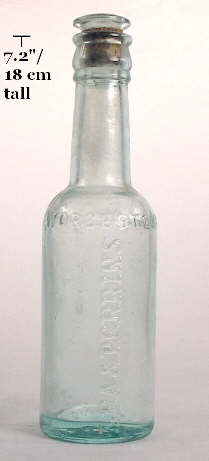 The
club style sauce bottle is a distinctive shape that is closely
identified with sauces intended for meats, and in particular, various
brands of Worcestershire
sauce. The origin of this style was apparently the bottle designed by
or for
the Lea &
Perrins® (L&P) company (illustration below & picture to the
left) and which was first reportedly used in the 1840s (Rinker 1968; Rock 2001).
Due to the incredible success of L&P, the sauce was copied by
scores of other companies and put up in bottles of the same shape
as L&P - often with the same embossing pattern (just different lettering
for the producer).
L&P pursued trademark infringements extensively and successfully during
the early 20th century (Zumwalt 1980). Based on bottles observed by this author on
scores of 19th
and early 20th century historical sites, it appears that L&P still outsold all
of the other competitors combined by a wide margin (empirical
observations). Note: Since L&P was by far the biggest producer of
"club sauce" it is the bottle primarily covered here; the competitors
bottles would follow the same general dating guidelines though not the
company specific ones, of course. The
club style sauce bottle is a distinctive shape that is closely
identified with sauces intended for meats, and in particular, various
brands of Worcestershire
sauce. The origin of this style was apparently the bottle designed by
or for
the Lea &
Perrins® (L&P) company (illustration below & picture to the
left) and which was first reportedly used in the 1840s (Rinker 1968; Rock 2001).
Due to the incredible success of L&P, the sauce was copied by
scores of other companies and put up in bottles of the same shape
as L&P - often with the same embossing pattern (just different lettering
for the producer).
L&P pursued trademark infringements extensively and successfully during
the early 20th century (Zumwalt 1980). Based on bottles observed by this author on
scores of 19th
and early 20th century historical sites, it appears that L&P still outsold all
of the other competitors combined by a wide margin (empirical
observations). Note: Since L&P was by far the biggest producer of
"club sauce" it is the bottle primarily covered here; the competitors
bottles would follow the same general dating guidelines though not the
company specific ones, of course.
The club sauce bottle style followed the same design exceptionally close across
a wide time span, from brand
to brand, and in the different though relatively limited sizes that were
produced. These bottles are
always cylindrical, relatively tall and narrow in cross-section (between 3
to 4 times taller than wide), have parallel
vertical body sides and virtually parallel neck sides (usually with a very
slight taper towards the base of the finish), the
neck/finish combination is about the same height as the body
from the heel to the base of the steep shoulder, and are almost
always topped with the distinctive three-part
club sauce
finish, though on occasion it is found with a two-part mineral type
finish (Lunn 1981). Earlier club sauce bottles will tend to have some
variety to the finish, though bottles from the 1870s on almost always have
the "classic" three-part club sauce finish (Switzer 1974; Zumwalt 1980).
The earliest L&P bottles were cork sealed, although a large majority of
the L&P and competitors bottles were closured with a combination glass
stopper & shell cork with a club sauce finish having a cork resting ledge on the inside of the bore. That closure/finish
combination was used by L&P until 1958 when a plastic pour spout and
external screw thread finish was adopted and is still in use today (Anonymous
1958; Rinker 1968;
Zumwalt 1980; Rock 2001). Click
Glass & Cork
closure to view the section of the Bottle Closures page that covers
this type closure. Click on the
IGCo 1906 pages 204-205 to view the Illinois Glass Company (Alton, IL.) offering of a "Worcestershire or
Club Sauce" bottle in 3 sizes with "Shell Corks and Glass Stoppers to
fit" (lower right corner). The Illinois Glass Company
illustration clearly shows that their version came with the distinctive
three-part club sauce finish.
 The bottle pictured
above is an early machine-made (1910-1920) Lea & Perrins
bottle embossed with LEA
& PERRINS (vertically on the body) and WORCESTERSHIRE SAUCE
(horizontally on the shoulder), which was the typical embossing for these bottles for
about 70 years, i.e. 1850s to about 1920. This particular example also has J D
/ S / 26 embossed on the base which is for
John Duncan & Sons (New York, NY) - aka John Duncans' Sons
- who were the American licensees for importing the sauce from about 1877 until 1930. (In 1930 L&P was
bought by the company that made the competing HP Sauce according the L&P
website [link below].) The L&P sauce was reportedly
imported into the U. S. from about 1877 to 1900 in casks and then bottled by
Duncan. Sometime around 1900 to 1902 the secret formula was given to
Duncan and a plant for
producing the sauce from imported materials was built in the U. S. (Rinker 1968;
Lunn 1981; L&P website 2007). The embossed bottles were
apparently discontinued in 1920-1921 and unembossed, label only bottles of
the same distinctive shape used after that. Aqua glass was also reportedly discontinued
in 1944, though may have largely disappeared by the early 1930s in favor
of colorless glass (Rinker 1968; Toulouse 1971; Zumwalt 1980; Lunn 1981; Rock 2001).
(Note: The L&P bottles today have embossing once again, though only on
the shoulder.) Click
on the following links for more images of the pictured bottle:
base view showing the J D
/ S / 26 embossing and the shell encased stopper to the left (note: the
"26" is most likely a mold number with no known significance at
this point in time);
close-up of
the front shoulder, neck and finish;
close-up of the back shoulder, neck
and finish. This bottle exhibits evidence of early machine
manufacture in that it has relatively crude wavy glass, multiple
small bubbles, and uneven base glass distribution. The bottle pictured
above is an early machine-made (1910-1920) Lea & Perrins
bottle embossed with LEA
& PERRINS (vertically on the body) and WORCESTERSHIRE SAUCE
(horizontally on the shoulder), which was the typical embossing for these bottles for
about 70 years, i.e. 1850s to about 1920. This particular example also has J D
/ S / 26 embossed on the base which is for
John Duncan & Sons (New York, NY) - aka John Duncans' Sons
- who were the American licensees for importing the sauce from about 1877 until 1930. (In 1930 L&P was
bought by the company that made the competing HP Sauce according the L&P
website [link below].) The L&P sauce was reportedly
imported into the U. S. from about 1877 to 1900 in casks and then bottled by
Duncan. Sometime around 1900 to 1902 the secret formula was given to
Duncan and a plant for
producing the sauce from imported materials was built in the U. S. (Rinker 1968;
Lunn 1981; L&P website 2007). The embossed bottles were
apparently discontinued in 1920-1921 and unembossed, label only bottles of
the same distinctive shape used after that. Aqua glass was also reportedly discontinued
in 1944, though may have largely disappeared by the early 1930s in favor
of colorless glass (Rinker 1968; Toulouse 1971; Zumwalt 1980; Lunn 1981; Rock 2001).
(Note: The L&P bottles today have embossing once again, though only on
the shoulder.) Click
on the following links for more images of the pictured bottle:
base view showing the J D
/ S / 26 embossing and the shell encased stopper to the left (note: the
"26" is most likely a mold number with no known significance at
this point in time);
close-up of
the front shoulder, neck and finish;
close-up of the back shoulder, neck
and finish. This bottle exhibits evidence of early machine
manufacture in that it has relatively crude wavy glass, multiple
small bubbles, and uneven base glass distribution.
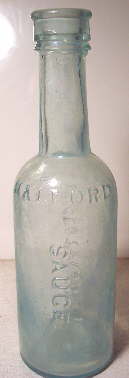 The
illustration to the right
is of a bottle with the same body embossing pattern as the example above but is
60+ years older. (Illustration courtesy of California State Parks.)
The illustrated example is of one of the earliest molds
for L&P that came from the context of a mid-19th century historic site in
"Old Town" San Diego, i.e., 1855-1865 (Peter Schulz pers. comm. 2007).
Other similar examples are known to date to the early 1850s (Lunn
1981). These earlier examples typically have a crudely applied "club sauce" finish,
were (probably) blown in
a post-bottom mold, and lack evidence of air venting. The A C
B Co embossed on the base is the makers mark for Aire and Calder Glass Bottle
Company (Castleford, Yorkshire, England) who are conclusively known to
have produced these bottles (Lunn 1981; Rock 2001), although some
authors attributed these bottles to the
Albion Bottle Company of Worchester, England (Rinker 1968).
Although neither of these glass company names perfectly fits the initials
on the base, other bottle types have been noted that are embossed with
AIRE & CALDER BOTTLE CO. - a perfect fit to the initials. In any
event, the A C B Co bottles are the earliest versions typically found in the
U. S. Click
ACBCo to view an image of this base embossing on an example salvaged from the
SS Republic© and thus known to date
from 1865 when that ship sank. Click
Lea & Perrins to view this same 1865 bottle in its entirety.
(Photos by George Salmon Photography, courtesy of Odyssey Marine Exploration) The
illustration to the right
is of a bottle with the same body embossing pattern as the example above but is
60+ years older. (Illustration courtesy of California State Parks.)
The illustrated example is of one of the earliest molds
for L&P that came from the context of a mid-19th century historic site in
"Old Town" San Diego, i.e., 1855-1865 (Peter Schulz pers. comm. 2007).
Other similar examples are known to date to the early 1850s (Lunn
1981). These earlier examples typically have a crudely applied "club sauce" finish,
were (probably) blown in
a post-bottom mold, and lack evidence of air venting. The A C
B Co embossed on the base is the makers mark for Aire and Calder Glass Bottle
Company (Castleford, Yorkshire, England) who are conclusively known to
have produced these bottles (Lunn 1981; Rock 2001), although some
authors attributed these bottles to the
Albion Bottle Company of Worchester, England (Rinker 1968).
Although neither of these glass company names perfectly fits the initials
on the base, other bottle types have been noted that are embossed with
AIRE & CALDER BOTTLE CO. - a perfect fit to the initials. In any
event, the A C B Co bottles are the earliest versions typically found in the
U. S. Click
ACBCo to view an image of this base embossing on an example salvaged from the
SS Republic© and thus known to date
from 1865 when that ship sank. Click
Lea & Perrins to view this same 1865 bottle in its entirety.
(Photos by George Salmon Photography, courtesy of Odyssey Marine Exploration)
One example (of dozens possible) of a competitor to L&P was the product contained in the bottle to the left which is
identical in form to the L&P bottles. It is
embossed horizontally on the shoulder with HALFORD - HALFORD, on the
front vertically with LEICESTERSHIRE and on the back vertically with SAUCE.
(Images off of eBay©.) These
bottles contained Halford's Table Sauce which was advertised in
1880 as follows:
“The Most Perfect Relish of the Day.
An absolute Remedy for Dyspepsia. Invaluable to all Good Cooks.
A Nutritious Combination for Children. Invaluable for Soups, Hashes,
Cold Meats, and Entrées" (advertisement found on internet).
Even meat sauce claimed medicinal
properties in the 19th century! This bottle has a crudely applied
club sauce style finish, was blown in a post-bottom mold, and likely had no
evidence of mold air venting - all features supporting a manufacturing
date of about 1865 to 1885. These bottles were likely manufactured
in England during the noted period as American and English bottle making
technology at that time was roughly on a par with each other (Zumwalt
1980; empirical observations). Click on
the following links for more images of this club sauce bottle:
base view;
back and shoulder view;
front and shoulder view.
Lea &
Perrins® bottles are quite
likely the most commonly found embossed bottle on mid-19th to early 20th century
historic sites. The author has observed them in the trash dumps
ranging from the fanciest big city hotels to isolated sheep camps in the
Great Basin. They came in at least three sizes - half pint (probably the most
common size), pint, and quart although the two larger sizes at least were
likely "scant" sizes, i.e., did not quite hold the full quantity (Illinois
Glass Co. 1903, 1906). Later mouth-blown bottles are embossed on the base
with J D S (and usually a mold number) like the machine-made bottle
discussed above. Some of these late mouth-blown bottles were
reportedly made in England - possibly by Aire and Calder or
Albion or possibly neither
(Toulouse 1971).
An image of a different club sauce style bottle is
available by clicking on the following link:
-
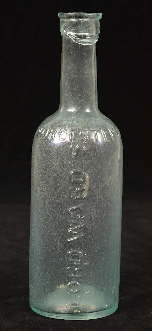 LORD WARD'S / WORCESTERSHIRE SAUCE - This 8" bottle is embossed
vertically (LORD WARD'S) on the body and horizontally (WORCESTERSHIRE
SAUCE) around the shoulder imitating precisely the embossing pattern
of the much more popular Lea & Perrins bottles of the era.
These bottles have the diagnostic features typical of its known age of
1865, i.e., very crudely formed club sauce applied finish, lack of both
mold air venting and pontil scar, and an overall crudity bespeaking its
Civil War era manufacture. Little is known about the company
though this bottle is known to date from 1865 as it was recovered from
the Steamship Republic© which sank off the
coast of Georgia during late October of that year (Gerth 2006). (Photo by George
Salmon Photography, courtesy of Odyssey Marine Exploration.) LORD WARD'S / WORCESTERSHIRE SAUCE - This 8" bottle is embossed
vertically (LORD WARD'S) on the body and horizontally (WORCESTERSHIRE
SAUCE) around the shoulder imitating precisely the embossing pattern
of the much more popular Lea & Perrins bottles of the era.
These bottles have the diagnostic features typical of its known age of
1865, i.e., very crudely formed club sauce applied finish, lack of both
mold air venting and pontil scar, and an overall crudity bespeaking its
Civil War era manufacture. Little is known about the company
though this bottle is known to date from 1865 as it was recovered from
the Steamship Republic© which sank off the
coast of Georgia during late October of that year (Gerth 2006). (Photo by George
Salmon Photography, courtesy of Odyssey Marine Exploration.)
Dating summary/notes: Given the wide span of
production for this style, i.e. from as early as the 1840s to as late as the mid-20th century
(and even in a similar form today), the dating of club sauce bottles can
not be done based on shape alone. Instead, it must be done based on
manufacturing based diagnostic features (like found throughout this
website) and/or through research of the historical record when possible
with company/product embossed bottles or those with the original labels intact.
However, Lea &
Perrins® bottles do have some fairly precise dating parameters as
follows. Please note that these dating parameters pertain to bottles
found in the U. S., not Canada or other countries (Lunn 1981):
- Some of the earliest bottles - early 1850s to
possibly the early 1860s - will often (but not always) have pontil scars and no base inscription
(Zumwalt 1980; Lunn 1981).
- L&P bottles with the
A C B Co on the base date from the late
1850s or early 1860s to about 1877. (Note: This base embossing can
be found on bottles imported into Canada up until the early 1920s
[Lunn 1981].)
- Mouth-blown examples with
J D S on the base date from no earlier than about 1878 and
as late as
the early to mid 1910s.
- Machine-made examples with
J D S
on the base date from the mid 1910s to 1920 or 1921, at which point John
Duncan's Sons began using plain, unembossed bottles of the same
shape.
- Some mouth-blown bottles may have been
produced as late as the 1920s or 1930s, though this has not been
confirmed and is considered unlikely (Lunn 1981; Rock 2001; empirical
observations).
- "Green" glass (aqua) was discontinued in 1944
and likely changed to colorless glass at that time for the
non-embossed L&P bottles of that era.
- Machine-made bottles with the club sauce finish and
glass/cork stopper date prior to 1958; those with
external screw threads date after that time (Anonymous 1958).
L&P still comes in the same shaped glass bottles today
but with an external screw thread finish, dark amber in color (not aqua or
colorless),
and with LEA & PERRINS shoulder embossing. The following link is to the official website for Lea &
Perrins®:
http://www.leaperrins.com/about/heritage.php
|
|
Barrel (and other
shaped) mustards
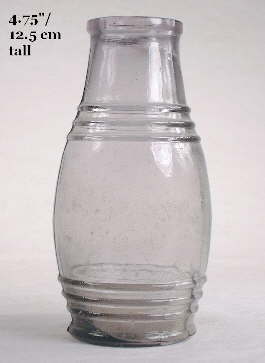 The
earliest bottles used for mustard (dry and/or prepared) during Colonial
times and the early days of the U. S. were the same as those used for
snuff (McKearin & Wilson 1978). Click
mid-19th century snuff bottle to see an example. Mustard was most commonly packaged in stylized "barrel" shaped bottles
from the mid-19th century until well into the 20th. As with all the
sauces/condiments covered here, mustard was almost a culinary requirement during the
19th century (and before as its use dates back to ancient times) to spice up
otherwise bland dishes and to cover up the off flavors of foods in the age
before refrigeration and other effective food preservation techniques.
Mustard was also thought to be a cure for ailments ranging from congestion
to hysteria, snakebite to bubonic plague (Gerth 2006).
Although bottled in a variety of wide mouth, typically squatty bottles, mustard
was commonly bottled in barrel shapes for much of the time period covered
by this website. The
earliest bottles used for mustard (dry and/or prepared) during Colonial
times and the early days of the U. S. were the same as those used for
snuff (McKearin & Wilson 1978). Click
mid-19th century snuff bottle to see an example. Mustard was most commonly packaged in stylized "barrel" shaped bottles
from the mid-19th century until well into the 20th. As with all the
sauces/condiments covered here, mustard was almost a culinary requirement during the
19th century (and before as its use dates back to ancient times) to spice up
otherwise bland dishes and to cover up the off flavors of foods in the age
before refrigeration and other effective food preservation techniques.
Mustard was also thought to be a cure for ailments ranging from congestion
to hysteria, snakebite to bubonic plague (Gerth 2006).
Although bottled in a variety of wide mouth, typically squatty bottles, mustard
was commonly bottled in barrel shapes for much of the time period covered
by this website.
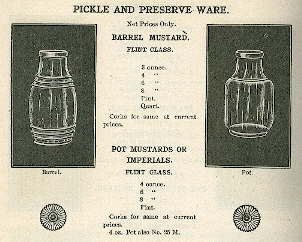 Barrel
mustard bottles - based on glassmaker catalogs and the authors empirical
observations - are dominated by those with
3 molded rings (aka staves, bands) above and below the central label area, like the examples pictured
here. Other conformations ranging from 2 to at least 6
rings have also been noted as well as some with vertical staves. Most
examples have rings that are separated by a distinct space, like the
example above left. Mustard was also packaged in other shapes of ceramic
and glass bottles (examples discussed below) though the barrel shape is the most closely associated
with the product (Switzer 1974; Zumwalt 1980). See pages
208-211 of the
1906 Illinois Glass Company catalog which offered the standard
barrel as well as about a dozen other shapes, including one that was beer
mug shaped! The image to the right above is from the 1906 Illinois
Glass Company catalog (page 208)
and shows their barrel mustard offering (left barrel bottle available in 6 sizes) and what is likely the second most common general
shape of that era for containing mustard - the "pot mustard" (right
bottle). Barrel
mustard bottles - based on glassmaker catalogs and the authors empirical
observations - are dominated by those with
3 molded rings (aka staves, bands) above and below the central label area, like the examples pictured
here. Other conformations ranging from 2 to at least 6
rings have also been noted as well as some with vertical staves. Most
examples have rings that are separated by a distinct space, like the
example above left. Mustard was also packaged in other shapes of ceramic
and glass bottles (examples discussed below) though the barrel shape is the most closely associated
with the product (Switzer 1974; Zumwalt 1980). See pages
208-211 of the
1906 Illinois Glass Company catalog which offered the standard
barrel as well as about a dozen other shapes, including one that was beer
mug shaped! The image to the right above is from the 1906 Illinois
Glass Company catalog (page 208)
and shows their barrel mustard offering (left barrel bottle available in 6 sizes) and what is likely the second most common general
shape of that era for containing mustard - the "pot mustard" (right
bottle).
Barrel mustards are typified by the fairly uniform
shapes shown here. Besides the molded rings and cylindrical shape, these bottles have
relatively wide bores (1" or more) for easy product access, usually a
distinct pedestal heel/base, a narrow banded one part finish, and a body that
distinctly bulges outwards in the middle with both the finish and base being
narrower in diameter. Glass makers catalogs, including
the Illinois Glass Company, referred to these
bottles as "barrel mustards" and offered them sizes ranging from 3 oz. to
a quart though the most commonly encountered size seems to be around 6-8 ounces (Illinois
Glass Co. 1903,1906,1911;
empirical observations). By 1920, the barrel mustards were
being offered with screw thread finishes (for the "American Metal Cap") by
the Illinois Glass Company and cork finish examples were apparently no longer
available (Illinois Glass Co. 1920). Barrel mustards (and other wide mouth
food bottles & jars in general) were some of the earliest types that
transitioned from the cork to some other finish as corks are an increasingly unreliable sealing closure as the
bottle bore becomes larger. This appears to be so because the
surface area against the cork increases allowing more opportunity for the
cork to not fit well (Lief 1965). Interestingly enough, the 1920 Illinois Glass Company catalog noted
that their barrel mustard style could "...only be sold on and west of the Mississippi
River." Why? Some type of agreement with competitors?
 The
barrel mustard pictured above is an 8 oz. size (measured to
the top ring) and the general type most commonly encountered.
It has a tooled one-part finish (more or less a "wide patent" or "bead"
type), made from colorless glass with a slight amethyst tint, blown in a
cup-bottom mold although with no obvious evidence of mold air venting making
the likely production date between 1880 and 1900. Click on the following links to view more images of this
typical size and design bottle:
base view;
close-up of the
upper body, neck, and finish with some of the tooling striations in
evidence and the ending point of the side mold seam
(where it was "wiped out") fairly obvious. This mold seam ending point marks the furthest point on the
"neck" that the outside pads of the
finishing tool could reach. The
barrel mustard pictured above is an 8 oz. size (measured to
the top ring) and the general type most commonly encountered.
It has a tooled one-part finish (more or less a "wide patent" or "bead"
type), made from colorless glass with a slight amethyst tint, blown in a
cup-bottom mold although with no obvious evidence of mold air venting making
the likely production date between 1880 and 1900. Click on the following links to view more images of this
typical size and design bottle:
base view;
close-up of the
upper body, neck, and finish with some of the tooling striations in
evidence and the ending point of the side mold seam
(where it was "wiped out") fairly obvious. This mold seam ending point marks the furthest point on the
"neck" that the outside pads of the
finishing tool could reach.
The barrel mustard bottle
to the right is a relatively early example embossed horizontally on one side
between the two sets of rings with MOUTARDE DIAPHANE / LOUIT FRERES & CO. (Zumwalt 1980).
"Diaphanous" (implying a
very fine product) mustard and similar other imported versions were
apparently the "Grey Poupon" of the of the mid-19th century. These
bottles were usually made of
colorless or aqua glass; very rarely in other colors. (This bottle
also has a faint "straw" cast to the glass indicating the possible early
use of selenium and/or arsenic to decolorize the glass.) Click on
base view to view an image of the base of this bottle which exhibits a
faint blowpipe type pontil scar (pointed out in image) though the scar has
a diffuseness to it that is reminiscent of a sand pontil. The bottle
body has no evidence of air venting and was
blown in a post-bottom mold although the side mold seam just barely curls
around the heel to join with an apparent post-bottom mold seam.
(Note: This company still produces the same mustard brand today, bottled
in similar bottles which now - and since the 1920s or 1930s - utilizes a
screw cap/finish instead of a cork. Click
1930s screw top example to see such.)
Very similar shaped mustard bottles of French origin with
pontil scars were found on the Steamship Bertrand which sank in the
Missouri River in April 1865. These mustard bottles were among the very few bottle types salvaged
from that ship that exhibited pontil scars when this author viewed the
collection in Iowa recently (empirical observations 2015). The Bertrand
mustards were a bit unusual in that they had 4 closely stacked rings
instead of three spaced ones, though the
rings were in the usual positions above and below the open label area (Switzer 1974).
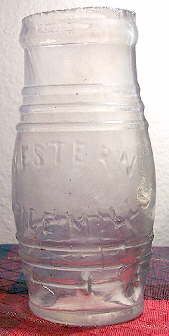 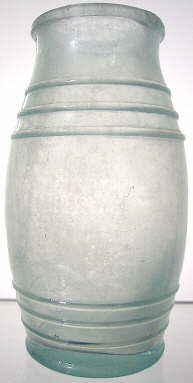 The
Civil War (1860s) era mustard barrel to the left is embossed with
WESTERN / SPICE MILLS and is a very crudely made, early mustard bottle
although it is not pontil scarred. (Image from eBay®.)
It is 4¾" tall, colorless (faintly gray), and almost certainly has no evidence of
mold air venting. It also has a very crudely
cracked-off
(or burst-off) finish with just
a bit of grinding done to the finish rim to keep from being dangerously sharp.
Western Spice Mills was a St. Louis, MO. firm which, being at
the gateway to the rapidly opening West, did a lot of business on the
upper Missouri River as well as downstream along the Mississippi River.
Gothic style pepper sauce bottles with this company name embossed were found
on the Steamship Bertrand (1865) and on the Steamboat Arabia which
sank in the Missouri River in 1856. Although early information on
the company is sparse it obviously dated as far back as 1856 and is known
to have continued in business until at least 1877 (Switzer 1974; Zumwalt
1980; Hawley 1998). The
Civil War (1860s) era mustard barrel to the left is embossed with
WESTERN / SPICE MILLS and is a very crudely made, early mustard bottle
although it is not pontil scarred. (Image from eBay®.)
It is 4¾" tall, colorless (faintly gray), and almost certainly has no evidence of
mold air venting. It also has a very crudely
cracked-off
(or burst-off) finish with just
a bit of grinding done to the finish rim to keep from being dangerously sharp.
Western Spice Mills was a St. Louis, MO. firm which, being at
the gateway to the rapidly opening West, did a lot of business on the
upper Missouri River as well as downstream along the Mississippi River.
Gothic style pepper sauce bottles with this company name embossed were found
on the Steamship Bertrand (1865) and on the Steamboat Arabia which
sank in the Missouri River in 1856. Although early information on
the company is sparse it obviously dated as far back as 1856 and is known
to have continued in business until at least 1877 (Switzer 1974; Zumwalt
1980; Hawley 1998).
The
aqua barrel bottle to the right is approximately 4" tall, has a rolled
(outward) finish It could be of either American or European origin
and likely dates from the 1860 to 1880 era. Aqua was certainly
the second most common color for this style, though still lags behind
colorless glass which was for some reason the standard "color" of
choice for mustard bottling. This was true even prior to the 1880s when colorless bottles were relatively uncommon as they were
more expensive to produce than aqua glass (empirical observations).
Other images of barrel and non-barrel mustard bottles are
available by clicking on the following links. This helps show
a bit of the diversity of shape found in these bottles:
-
Pair of barrel mustards - These two barrel mustards date from 1865
as they were recovered from the Steamship Republic© which sank off the
coast of Georgia during late October of that year. Both are 5" tall,
have typical rolled/tooled one-part finishes, lack mold air venting, and
have smooth (non-pontiled) bases. The bottle on the right in the
linked picture has staining most likely from contact with the metal
parts of the sunken ship (Gerth 2006). (Photo by George
Salmon Photography, courtesy of Odyssey Marine Exploration.)
-
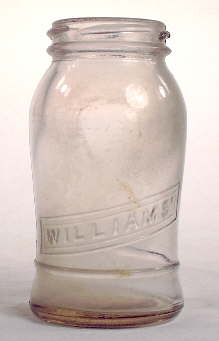 WILLIAMS'
- This was most likely a West Coast mustard brand and is embossed WILLIAMS'
in a "banner" on one lower side. It is machine-made by a
blow-and-blow machine (no valve mark), about 4.3" (11 cm) tall, has a
wide (1.5") bore, lug type external thread finish, and a slight amethyst
tint. It has an "S" in a five-pointed star
embossed on the base
which was the makers mark for the Southern Glass Company
(Los Angeles, CA.) in business from 1918 to 1930, though they used
that mark from 1925 to 1930 (Toulouse 1971; Lockhart et al. 2009b). This bottle shows that the use of manganese dioxide
to decolorize glass - the reason for the pink tint - continued until at
least the late 1920s at some glass companies. Click on the
following links to view more images of this bottle:
base view showing the interesting makers mark;
close-up of the shoulder and finish (no real neck) showing the lug
type external screw threads. WILLIAMS'
- This was most likely a West Coast mustard brand and is embossed WILLIAMS'
in a "banner" on one lower side. It is machine-made by a
blow-and-blow machine (no valve mark), about 4.3" (11 cm) tall, has a
wide (1.5") bore, lug type external thread finish, and a slight amethyst
tint. It has an "S" in a five-pointed star
embossed on the base
which was the makers mark for the Southern Glass Company
(Los Angeles, CA.) in business from 1918 to 1930, though they used
that mark from 1925 to 1930 (Toulouse 1971; Lockhart et al. 2009b). This bottle shows that the use of manganese dioxide
to decolorize glass - the reason for the pink tint - continued until at
least the late 1920s at some glass companies. Click on the
following links to view more images of this bottle:
base view showing the interesting makers mark;
close-up of the shoulder and finish (no real neck) showing the lug
type external screw threads.
-
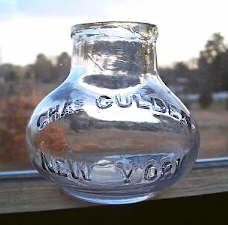 CHAs. GULDEN / NEW YORK - This is embossed on one side of a
bulbous bodied mustard bottle from this famous condiments firm.
This bottle was certainly used for mustard; the Gulden brand is
still being made today though now packaged (unfortunately) in plastic. It has a
wide bore to facilitate extraction of the product, a tooled one-part finish (like most
mustards), blown in a cup-bottom mold, and likely has air venting though
that is not certain (image off eBay®).
From these features it is reasonable to conclude that the bottle dates
somewhere between the late 1880s to early 1910s. Similar "mustard"
bottles were made by and listed in the 1894 Agnew Co. catalog
(Agnew 1894). This specific
design for Gulden was first patented by the company in 1875 and variations
were used until the late 20th century (Zumwalt 1980). Click
1922 Good Housekeeping advertisement to see an ad for
Gulden's mustard. Click
screw thread finish Gulden's to see a bottle like that in the
1922 advertisement (apologies for the poor quality image from
eBay®). CHAs. GULDEN / NEW YORK - This is embossed on one side of a
bulbous bodied mustard bottle from this famous condiments firm.
This bottle was certainly used for mustard; the Gulden brand is
still being made today though now packaged (unfortunately) in plastic. It has a
wide bore to facilitate extraction of the product, a tooled one-part finish (like most
mustards), blown in a cup-bottom mold, and likely has air venting though
that is not certain (image off eBay®).
From these features it is reasonable to conclude that the bottle dates
somewhere between the late 1880s to early 1910s. Similar "mustard"
bottles were made by and listed in the 1894 Agnew Co. catalog
(Agnew 1894). This specific
design for Gulden was first patented by the company in 1875 and variations
were used until the late 20th century (Zumwalt 1980). Click
1922 Good Housekeeping advertisement to see an ad for
Gulden's mustard. Click
screw thread finish Gulden's to see a bottle like that in the
1922 advertisement (apologies for the poor quality image from
eBay®).
-
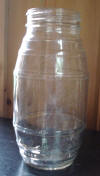 Mid-20th
century mustard bottle - The pictured bottle most likely dates from
between about 1925 and 1940. (Photo courtesy Richard Mushing.) It was machine-made by the
Hazel-Atlas Glass Company (Wheeling, W. V.) based on the H over an A
makers mark on the base (it also has the numbers 5943 and 10 on
the base - both of unknown meaning), has a wide mouth external screw
thread finish, and was blown in a press-and-blow mold based on the
suction or ejection valve mark on the base. The H over an A makers
mark was used from about 1923 (when trademarked) to at least 1965
(Toulouse 1971; Lockhart et al. unpublished manuscript 2008). This
late style of mustard still retains the distinctive horizontal hoop
rings seen on examples from a century previous. These type screw
top mustard bottles are often seen in bottle makers catalogs from the
first third or so of the 20th century (Kearns-Gorsuch Bottle Co. 1916;
Fairmount Glass Works undated [late 1920s or early 1930s]). Mid-20th
century mustard bottle - The pictured bottle most likely dates from
between about 1925 and 1940. (Photo courtesy Richard Mushing.) It was machine-made by the
Hazel-Atlas Glass Company (Wheeling, W. V.) based on the H over an A
makers mark on the base (it also has the numbers 5943 and 10 on
the base - both of unknown meaning), has a wide mouth external screw
thread finish, and was blown in a press-and-blow mold based on the
suction or ejection valve mark on the base. The H over an A makers
mark was used from about 1923 (when trademarked) to at least 1965
(Toulouse 1971; Lockhart et al. unpublished manuscript 2008). This
late style of mustard still retains the distinctive horizontal hoop
rings seen on examples from a century previous. These type screw
top mustard bottles are often seen in bottle makers catalogs from the
first third or so of the 20th century (Kearns-Gorsuch Bottle Co. 1916;
Fairmount Glass Works undated [late 1920s or early 1930s]).
-
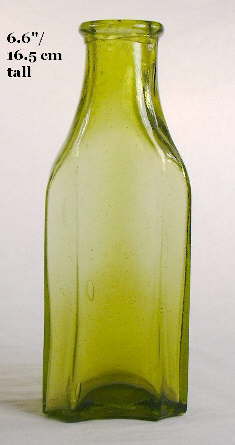 It
should be noted here that the
"spice" bottle style covered later on this page (image to
the right) was also commonly used for mustard during the last half of
the 19th century (Zumwalt 1980). It
should be noted here that the
"spice" bottle style covered later on this page (image to
the right) was also commonly used for mustard during the last half of
the 19th century (Zumwalt 1980).
- ...more to be added in the future.
Dating summary/notes: Many different
shapes were used for the packaging of mustard, though the stylized barrel
shape is the most closely associated with mustard for much of the time
period covered by this website. Unfortunately
(for dating utility based on shape) the barrel mustard style was made
a very long time, i.e., at least from the 1850s into the 1920s when
vertically paneled or fluted shapes rose in popularity (Kearns-Gorsuch
Bottle Co. 1916; Illinois Glass Co. ca. 1920; Fairmount Glass Works late
ca. 1930; Owens-Illinois Glass Co. 1940s; Zumwalt 1980). Given the wide
span of production, the dating of these bottles must be done based on
manufacturing based diagnostic features and/or through research of the
historical record when possible (which usually is not unless the example
has the original labels or is brand/producer embossed). Generally
speaking, the dating of these type bottles based on manufacturing related
diagnostic features follows quite well the guidelines presented throughout
this website and summarized on the
Bottle Dating page; see that page for more information.
A few type specific general dating observations are
possible with barrel
mustards:
- Earlier barrel mustards (early 1880s and
prior) tended to be somewhat squattier (proportionally wider) with a
wider bore or mouth, though these features are relative and only
moderately reliable in calling a bottle "earlier" or "later."
For example, a comparison of the first pictured bottle (latest
produced example pictured) to the second and fourth bottles shows this
subtle but observable difference. The third bottle pictured (Western
Spice Mills) is narrower in the body but has a level of
crudeness that strongly hints at an earlier production date. As
with just about everything in bottle dating and typing, there are
exceptions to most trends, though that does not necessarily negate the
utility of these trends when considered in hand with other information
and diagnostic features.
- Glass tipped or blowpipe pontil scars can be
found on some French-made mustard barrels (like the LOUIT FRERES
bottle above which is commonly found in the U. S.) later than would be
observed on other types of bottles; possibly as late as the mid-1870s
which is a decade+ later than typically seen on American-made
utilitarian type bottles (Switzer 1974; empirical observations).
- Many "later" barrel mustard bottles -
i.e., early 1900s (mouth-blown) until sometime during the Great
Depression (machine-made) - tended to have very widely spaced rings
and distinctly less taper to the entire bottle. Click on
1906 Illinois Glass Company catalog - page 208 to view an example
of this barrel type. The specific example - the "St. Louis or
Tin-Top Mustard" - is illustrated in the lower left hand
corner of the page.
Machine-made examples of this later variation have been observed from
at least as early as 1906 (semi-automatic machine manufacture) to as late as the 1930s
(Illinois Glass Co. 1906; Fairmount Glass Works ca. 1930).
It should be noted that these types of barrel bottles
were occasionally used for other condiments like horseradish and likely
for various spices also. Conversely, the
"spice" bottle style covered later on this page was also commonly used
for mustard during the last half of the 19th century (Zumwalt 1980).
|
|
Other
sauce/condiment styles (including horse radish)
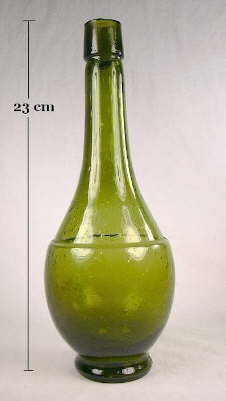 The sauce/condiment bottle shapes described in the
previous sections cover some of the most common shapes and designs for these
products. However, sauces were packaged
in a wide array of additional shapes during the period covered by this website,
i.e., the 19th through mid-20th centuries. Refer to Betty Zumwalt's
very informative 1980 book Ketchup, Pickles, Sauces - 19th Century Food in Glass
for more information on the subject and images of some of this
variety. (Note: This book is still available
new and used at sources like Amazon.com™, eBay®,
AbeBooks.com™, and others.) A few unusual
sauce shapes were covered in the ketchup bottles section above; shapes
which were likely used for non-ketchup sauce products also. For a
sampling of the sauce bottle variety offered by one early 20th century
bottle manufacturer, click
Illinois Glass Company 1906 catalog which is a page comprised
of scans of that company's entire 1906 catalog. In particular, look
at pages 200
through 205. The following are examples of a few other sauce or
condiment styles (including for ketchup) to show the variety. As
with most of these bottle typology pages, more examples will be added over
time. The sauce/condiment bottle shapes described in the
previous sections cover some of the most common shapes and designs for these
products. However, sauces were packaged
in a wide array of additional shapes during the period covered by this website,
i.e., the 19th through mid-20th centuries. Refer to Betty Zumwalt's
very informative 1980 book Ketchup, Pickles, Sauces - 19th Century Food in Glass
for more information on the subject and images of some of this
variety. (Note: This book is still available
new and used at sources like Amazon.com™, eBay®,
AbeBooks.com™, and others.) A few unusual
sauce shapes were covered in the ketchup bottles section above; shapes
which were likely used for non-ketchup sauce products also. For a
sampling of the sauce bottle variety offered by one early 20th century
bottle manufacturer, click
Illinois Glass Company 1906 catalog which is a page comprised
of scans of that company's entire 1906 catalog. In particular, look
at pages 200
through 205. The following are examples of a few other sauce or
condiment styles (including for ketchup) to show the variety. As
with most of these bottle typology pages, more examples will be added over
time.
Bulbous/decorative shaped sauces (not otherwise covered earlier):
This category is fairly broad with hundreds if not several thousand different
variations which have in common only that they were used for various
sauces/condiments and do not fit well in the categories above. This "category" of sauce bottles was fairly common as a group though the
different examples vary widely in specific shape and conformation; most
individual variations within this loose category would be considered uncommon as they
were not "standard" forms like the sauces covered earlier (Rinker
1968; Zumwalt 1980).
As an example, the likely sauce bottle pictured above is from the 1850-1870
era as it has a glass tipped pontil scar on the pedestal heel base, a crudely applied
one part oil finish, hundreds of bubbles in the glass, and lacks evidence of air venting
though it was blown in a cup-bottom mold - a feature largely found on
non-pontil scarred bottles. This appears to be an
early example
of cup-bottom mold use and may indicate a
later manufacture notwithstanding the presence of the pontil scar and
overall crudity which speaks of a pre-1870 manufacture.
It is also possible that this bottle was used for some other totally
different product (possibly a "specialty" barber bottle or used for
liquor) though it has similarity in general form to fancier sauce
bottles (Zumwalt 1980). Click on the following links to view more images of this bottle:
base view showing the glass tipped pontil scar;
close-up of the crudely applied oil
type finish.
The following are some additional
images/information of other styles of fancier sauce & condiment bottles:
-
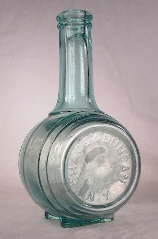 CHACE & DUNCAN / N. Y. - This uniquely shaped sauce bottle
was used by Chace & Duncan - New York City "sauce"
producers in business together between about 1877 and 1886
(Zumwalt 1980). It is embossed with the noted lettering on one end of the somewhat uniquely
shaped "barrel" body. This bottle exhibits manufacturing
characteristics of the later end of the noted company era (early to mid-1880s) in
that it has a tooled double ring finish though has crudeness to the
glass and no evidence of mold air venting. Click
side view to see such
of this bottle showing the distinctly "barrel" shape to the body. CHACE & DUNCAN / N. Y. - This uniquely shaped sauce bottle
was used by Chace & Duncan - New York City "sauce"
producers in business together between about 1877 and 1886
(Zumwalt 1980). It is embossed with the noted lettering on one end of the somewhat uniquely
shaped "barrel" body. This bottle exhibits manufacturing
characteristics of the later end of the noted company era (early to mid-1880s) in
that it has a tooled double ring finish though has crudeness to the
glass and no evidence of mold air venting. Click
side view to see such
of this bottle showing the distinctly "barrel" shape to the body.
- More to be added over time...
 Horse
radish: As with many food/condiment bottles, horse radish was bottled
in various shaped bottles. The general shape described and pictured here, with the bulge or ring at the junction of the neck and
shoulder, was a favored type container for dispensing horse radish. This
general style was also used for a variety of other food products which
needed a
wide mouth for content access and are virtually
identical to some of the "pickle" bottles
discussed next (Zumwalt 1980). The only sure way to tell if these
type bottles were used for horse radish (or whatever) is if they are
embossed and/or labeled as containing such, like both pictured bottles here. Horse
radish: As with many food/condiment bottles, horse radish was bottled
in various shaped bottles. The general shape described and pictured here, with the bulge or ring at the junction of the neck and
shoulder, was a favored type container for dispensing horse radish. This
general style was also used for a variety of other food products which
needed a
wide mouth for content access and are virtually
identical to some of the "pickle" bottles
discussed next (Zumwalt 1980). The only sure way to tell if these
type bottles were used for horse radish (or whatever) is if they are
embossed and/or labeled as containing such, like both pictured bottles here.
The
New England bottle pictured to the left is embossed on one
body panel with PURE HORSE / RADISH / H. D. GEER / THREE RIVERS / MASS. It
is square in cross-section, has a tooled one-part bead finish, was blown
in a cup-bottom mold, and has one (apparent) mold air venting mark
incorporated into the side mold seams at the same spot on opposite
shoulders. Click
base view to see such. The body has some crudity (sunken and wavy
glass) that in hand with the other diagnostic features indicates a likely
late 1880s to the early 1900s manufacture. A check of Zumwalt (1980)
shows this specific bottle covered under the section for D. H.
Geer, even though the bottle (the example pictured here and in Zumwalt's
book) is embossed with H. D. Geer. Originally this was
thought to be a mold engravers error in switching the initials around.
Since the initial writing of this section, the author has been in
correspondence with a descendant of the Geer family and has been informed
that there were two different Geer's in the food packaging industry
in Massachusetts - David H. Geer, whom is discussed in Zumwalt, and
Henry Denison Geer who was born in 1863 and listed as a "farmer and
fruit grower" in Three Rivers, Massachusetts - and the real user of this
bottle (pers. comm. with Susan Geer Downes 2008).
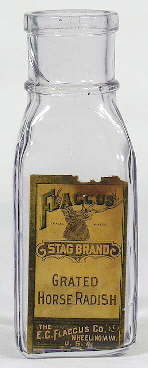 The
labeled mouth-blown horse radish bottle pictured to the right (photo from
eBay®) was used by the food packing
and preservation concern of E. C. Flaccus & Co. (Wheeling, WV.).
E. C. Flaccus was first listed as in business in 1898 and operated until 1920.
The stag's head trademark was registered in 1907 but noted that it had
been "used ten years" at that time (Zumwalt 1980; Caniff 1997).
This bottle has the typical horseradish shape with the ring at or near the neck/shoulder
junction, is rectangular in cross-section, has
a tooled one-part flat sided "packer" finish, and was almost certainly blown in a
cup-bottom mold with air venting. These features give a likely
manufacture date of 1900 to 1914 or so. After the latter date, the
majority of all wide
mouth bottles were being made by machines, although these types were being machine-made at least as
early as 1906 and probably a bit before (Illinois Glass Co. 1906). Click
IGCo. 1906 catalog - page 284-285 to view the page from the 1906
catalog that shows a "Machine-made" horse radish bottle of similar
conformation. The pictured bottle has no diagnostic embossing and is solely
identified by the label without which the bottle could not be
positively identified as this style was used for various preserved food
products, as noted earlier. The
labeled mouth-blown horse radish bottle pictured to the right (photo from
eBay®) was used by the food packing
and preservation concern of E. C. Flaccus & Co. (Wheeling, WV.).
E. C. Flaccus was first listed as in business in 1898 and operated until 1920.
The stag's head trademark was registered in 1907 but noted that it had
been "used ten years" at that time (Zumwalt 1980; Caniff 1997).
This bottle has the typical horseradish shape with the ring at or near the neck/shoulder
junction, is rectangular in cross-section, has
a tooled one-part flat sided "packer" finish, and was almost certainly blown in a
cup-bottom mold with air venting. These features give a likely
manufacture date of 1900 to 1914 or so. After the latter date, the
majority of all wide
mouth bottles were being made by machines, although these types were being machine-made at least as
early as 1906 and probably a bit before (Illinois Glass Co. 1906). Click
IGCo. 1906 catalog - page 284-285 to view the page from the 1906
catalog that shows a "Machine-made" horse radish bottle of similar
conformation. The pictured bottle has no diagnostic embossing and is solely
identified by the label without which the bottle could not be
positively identified as this style was used for various preserved food
products, as noted earlier.
The general shapes described here (square and
rectangular) were
used for horse radish until well into the 20th century. Bottle
makers catalogs from the 1920s, 1930s and 1940s indicate the style was
still in use, though by the late 1910s and early 1920s the finish had shifted to the
increasingly more popular external screw threads. By the end of the 1920s
virtually all bottles of this style had external screw thread finishes. The ring at the juncture of the
neck and shoulder did carry forward as an stylistic indicator of a horse
radish bottle until the 1940s (Illinois Glass Co. 1920,1925; Obear-Nester Glass Co. 1923;
Fairmount Glass Works ca. 1930; Lucas County Bottle Co.
ca. 1940).
The following are some additional
images/information of other horse radish bottles:
-
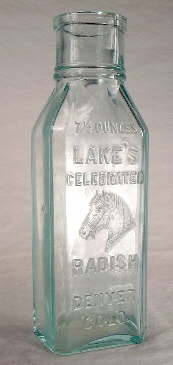 7
1/2 OZS. / LAKE'S / CELEBRATED / (horse's head) / RADISH / DENVER, /
COLO. - This is embossed on the front of this typical horse
radish bottle from the early 20th century. Louis Lake and G. H.
Neunsch (and others after 1911) manufactured this product between 1901
and about 1922. This bottle (7" tall, 2.2" wide and 1.6" deep)
with its tooled patent finish, cup-bottom mold production and multiple
mold air venting marks dates from between 1901 and the early 1910s
(Zumwalt 1980). Click on the following links to see more images of
this bottle:
base view;
close-up of the shoulder, neck and tooled finish. 7
1/2 OZS. / LAKE'S / CELEBRATED / (horse's head) / RADISH / DENVER, /
COLO. - This is embossed on the front of this typical horse
radish bottle from the early 20th century. Louis Lake and G. H.
Neunsch (and others after 1911) manufactured this product between 1901
and about 1922. This bottle (7" tall, 2.2" wide and 1.6" deep)
with its tooled patent finish, cup-bottom mold production and multiple
mold air venting marks dates from between 1901 and the early 1910s
(Zumwalt 1980). Click on the following links to see more images of
this bottle:
base view;
close-up of the shoulder, neck and tooled finish.
-
Additional bottle catalog illustrations of horse radish bottles can be
found at the following links:
Illinois Glass Company (1906):
Pickle
& Horse Radish - pages 190-191 ,
Pickle
& Horse Radish - pages 192-193
Illinois Glass Company (1920):
Page 89 -
Horse radish ,
Page 90 -
Horse radish (various styles)
Illinois Glass Company (1926):
Page 130 - Horse Radish Bottles
, Page 131 - Horse Radish Bottles
, Page 132 - Horse Radish Bottles
, Page 133 - Horse Radish Bottles
, Page 134 - Horse Radish Bottles
Dating summary/notes: Like most bottle
types listed on this page, the dating of most sauce and condiment bottles in general can not
be done based on shape alone. Instead, it must be done based on
manufacturing related diagnostic features (like found throughout this
website) and/or through research of the historical record when possible
with company embossed bottles or those with the original labels intact.
Generally speaking, the dating of these type bottles based on
manufacturing related diagnostic features follows quite well the
guidelines presented throughout this website and summarized on the
Bottle Dating page; see that page for more information.
|
|


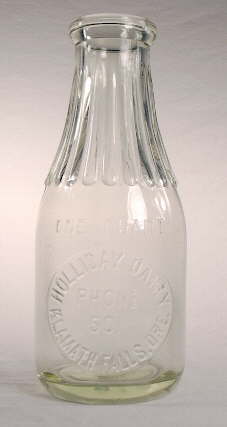 Although the variety of different
shaped glass containers used for food products was quite extensive, many classes of food bottles and
jars do share a couple traits in common. In particular, bottles/jars
intended for bulky solid food items (like preserved pickles, olives, fruits,
etc.) had to have a relatively wide mouth (bore)
in order to the facilitate the packing as well as extraction of these
products. (This is evident on the mid-19th century "cathedral" pickle bottle
pictured to the above left.) Some liquid food containers like milk
bottles (example to the right) also had relatively wide mouths for overall ease of use
(and cleaning for re-use) though
other more liquid food products (oil, sauces) worked quite well with
narrow mouth bottles. Many solid food bottle/jars also tended to be
larger sized bottles since food was (and is) consumed in larger quantities
than most other products like medicine or (hopefully) liquor. Of
note is the fact that since the preservation of the bottled food products
over time was of paramount importance, many food bottles/jars were designed around
the closure which was virtually always the primary critical link for long term
storage (Toulouse 1969a; Bender 1986). The incredible variety of fruit/canning jar closures were a
prime example of closure importance - a subject discussed later on this
page. (A "Lightning" bail type canning jar closure is shown on
the canning jar pictured below.)
Although the variety of different
shaped glass containers used for food products was quite extensive, many classes of food bottles and
jars do share a couple traits in common. In particular, bottles/jars
intended for bulky solid food items (like preserved pickles, olives, fruits,
etc.) had to have a relatively wide mouth (bore)
in order to the facilitate the packing as well as extraction of these
products. (This is evident on the mid-19th century "cathedral" pickle bottle
pictured to the above left.) Some liquid food containers like milk
bottles (example to the right) also had relatively wide mouths for overall ease of use
(and cleaning for re-use) though
other more liquid food products (oil, sauces) worked quite well with
narrow mouth bottles. Many solid food bottle/jars also tended to be
larger sized bottles since food was (and is) consumed in larger quantities
than most other products like medicine or (hopefully) liquor. Of
note is the fact that since the preservation of the bottled food products
over time was of paramount importance, many food bottles/jars were designed around
the closure which was virtually always the primary critical link for long term
storage (Toulouse 1969a; Bender 1986). The incredible variety of fruit/canning jar closures were a
prime example of closure importance - a subject discussed later on this
page. (A "Lightning" bail type canning jar closure is shown on
the canning jar pictured below.)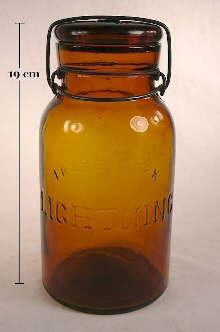 Due
to the similarities, this
typology section also
contains the large category of fruit/canning jars as they were definitely designed and used for
food preservation containers though envisioned and marketed as being
indefinitely re-usable (until broken) whereas the other food containers
discussed here were largely used once and discarded. (Note: As
discussed frequently on this
website, the re-use of "disposable" bottles of almost all types was common up until the
early 20th century; food bottles were likely no different and were
frequently re-used.) Canning
jars likely warrant a separate typology page (as has been suggested
by some reviewers) but have been addressed here for simplicity since they are a
category within the broad group of "food" bottles though
often treated separately by many authors. In addition,
these typing pages can only scratch the surface of the diversity of any
group - including canning jars. Contrary to most other food bottle categories, canning jars have
indeed received significant attention from researchers. The incredible
variation in jar brands, and in particular, the hundreds of different
closure types, has piqued the interest of collectors and researchers for
decades and inspired many authors to approach this category with zeal and
research depth (Toulouse 1969; Creswick & Rodrigues 1969; Roller 1983; Creswick
1987; others). Along with
figured flasks (McKearin & Wilson 1978) and possibly Western liquor
bottles (Thomas 1974, 1977, 1998a & b, 2002), canning jars have had some of the best historical
research done on them though all of the "good" books are long out of print.
Due
to the similarities, this
typology section also
contains the large category of fruit/canning jars as they were definitely designed and used for
food preservation containers though envisioned and marketed as being
indefinitely re-usable (until broken) whereas the other food containers
discussed here were largely used once and discarded. (Note: As
discussed frequently on this
website, the re-use of "disposable" bottles of almost all types was common up until the
early 20th century; food bottles were likely no different and were
frequently re-used.) Canning
jars likely warrant a separate typology page (as has been suggested
by some reviewers) but have been addressed here for simplicity since they are a
category within the broad group of "food" bottles though
often treated separately by many authors. In addition,
these typing pages can only scratch the surface of the diversity of any
group - including canning jars. Contrary to most other food bottle categories, canning jars have
indeed received significant attention from researchers. The incredible
variation in jar brands, and in particular, the hundreds of different
closure types, has piqued the interest of collectors and researchers for
decades and inspired many authors to approach this category with zeal and
research depth (Toulouse 1969; Creswick & Rodrigues 1969; Roller 1983; Creswick
1987; others). Along with
figured flasks (McKearin & Wilson 1978) and possibly Western liquor
bottles (Thomas 1974, 1977, 1998a & b, 2002), canning jars have had some of the best historical
research done on them though all of the "good" books are long out of print. 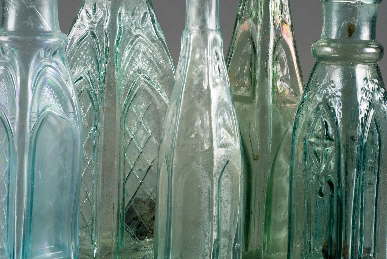 The
organization of this typology page is based on a mix of shape, dominant
design, contents, and/or closure type - often within the same category.
For instance, the first category - "Sauces & Condiments" - has
sub-categories based on a design theme ("Gothic", "Club"), shape
("Ribbed"), contents (Ketchup/Catsup), or a combination of two like design
and contents ("Barrel Mustard"). Other categories - like "Canning
Jars" - are largely based on dominant closure types. In Munsey's (1970) classic book "The Illustrated Guide to Collecting Bottles"
he used separate chapters for "Fruit Jars", "Food Bottles", "Milk Bottles",
and "Candy Bottles" - all of which are covered within this "Food Bottles & Canning Jars" typing page.
Conversely, Munsey also lumped into the "Food Bottles" chapter types which
are separated here into subject categories, i.e., "Sauces & Condiments", "Pickles &
Preserved Foods", and "Vegetable Oil & Salad Dressing Bottles"
- all of which also have
sub-categories under those main headings. Some other types - like
milk bottles - naturally fall out into their own category. In short,
there are many ways to divide and classify the universe of "food" bottles
(also called "culinary" bottles by some authors) and the author makes no claim
that his way is necessarily better than those used by
other authors (Munsey 1970; Switzer 1974). The organization used here simply made more sense given the author's experience and the
specific goals of this website. (The image to the right above is of
an assortment of gothic style food bottles known to date from 1865 as they
were recovered from the Steamship Republic© which sank off the
coast of Georgia during late October of that year. [Photo by George
Salmon Photography, courtesy of Odyssey Marine Exploration.])
The
organization of this typology page is based on a mix of shape, dominant
design, contents, and/or closure type - often within the same category.
For instance, the first category - "Sauces & Condiments" - has
sub-categories based on a design theme ("Gothic", "Club"), shape
("Ribbed"), contents (Ketchup/Catsup), or a combination of two like design
and contents ("Barrel Mustard"). Other categories - like "Canning
Jars" - are largely based on dominant closure types. In Munsey's (1970) classic book "The Illustrated Guide to Collecting Bottles"
he used separate chapters for "Fruit Jars", "Food Bottles", "Milk Bottles",
and "Candy Bottles" - all of which are covered within this "Food Bottles & Canning Jars" typing page.
Conversely, Munsey also lumped into the "Food Bottles" chapter types which
are separated here into subject categories, i.e., "Sauces & Condiments", "Pickles &
Preserved Foods", and "Vegetable Oil & Salad Dressing Bottles"
- all of which also have
sub-categories under those main headings. Some other types - like
milk bottles - naturally fall out into their own category. In short,
there are many ways to divide and classify the universe of "food" bottles
(also called "culinary" bottles by some authors) and the author makes no claim
that his way is necessarily better than those used by
other authors (Munsey 1970; Switzer 1974). The organization used here simply made more sense given the author's experience and the
specific goals of this website. (The image to the right above is of
an assortment of gothic style food bottles known to date from 1865 as they
were recovered from the Steamship Republic© which sank off the
coast of Georgia during late October of that year. [Photo by George
Salmon Photography, courtesy of Odyssey Marine Exploration.])